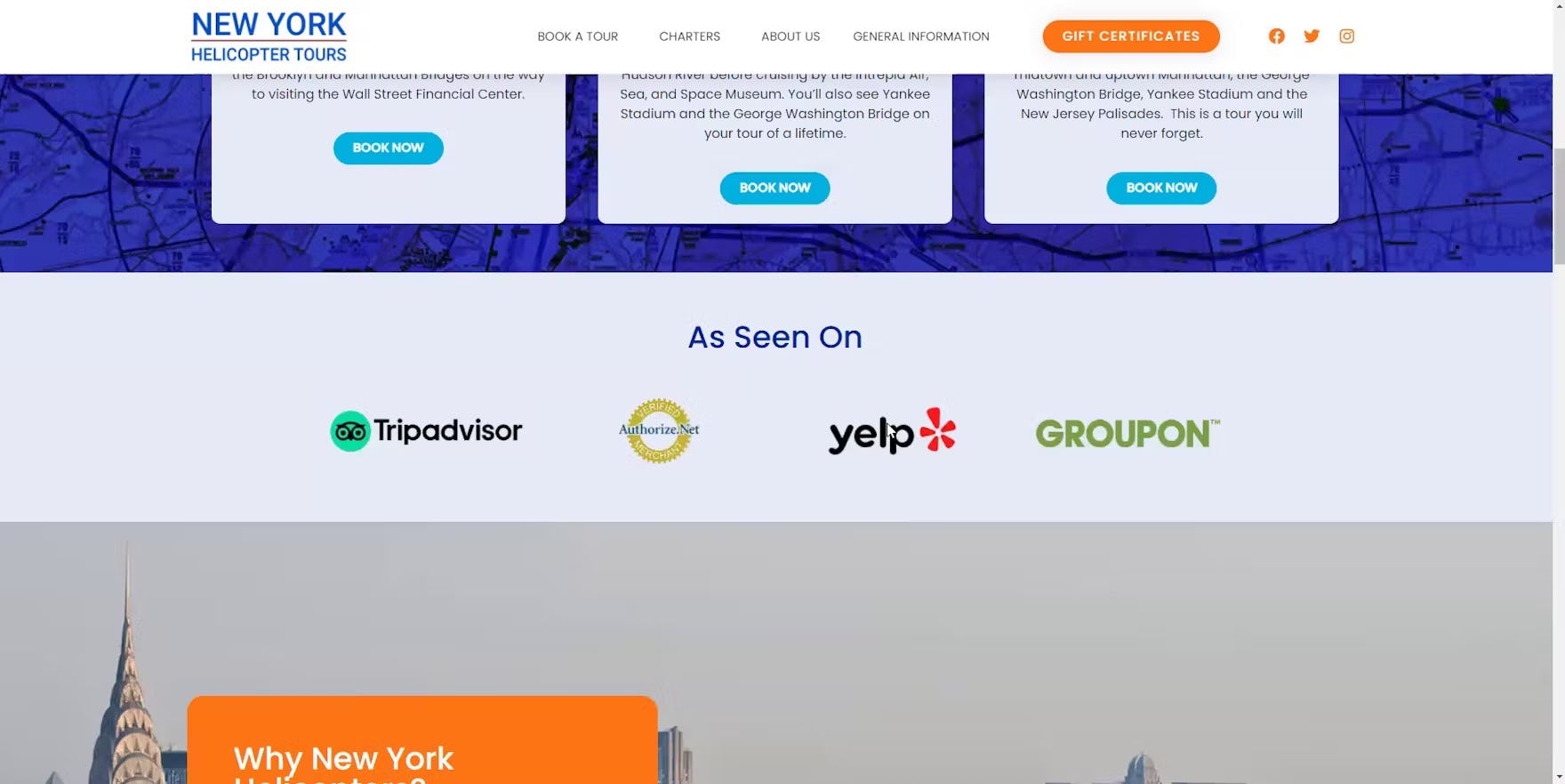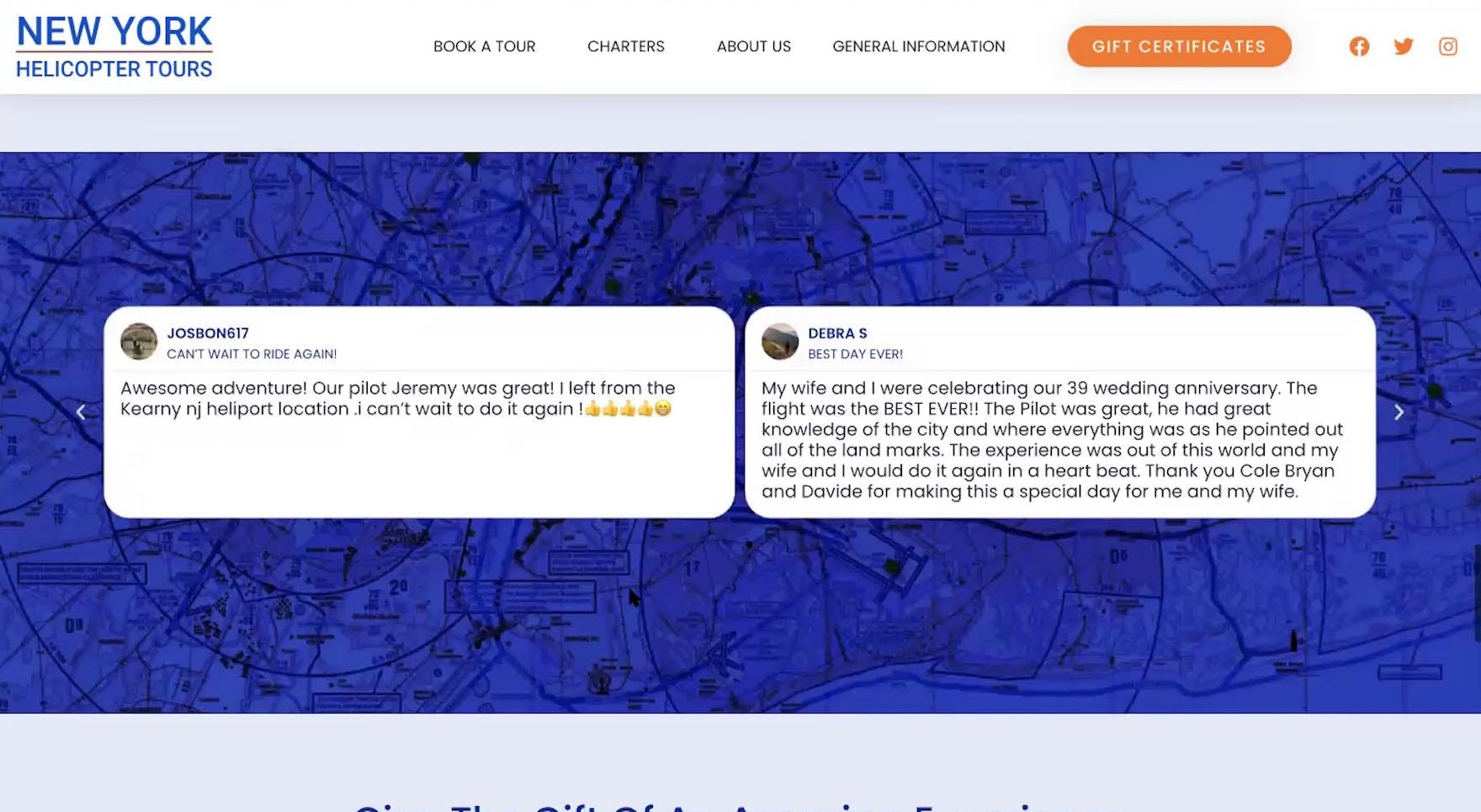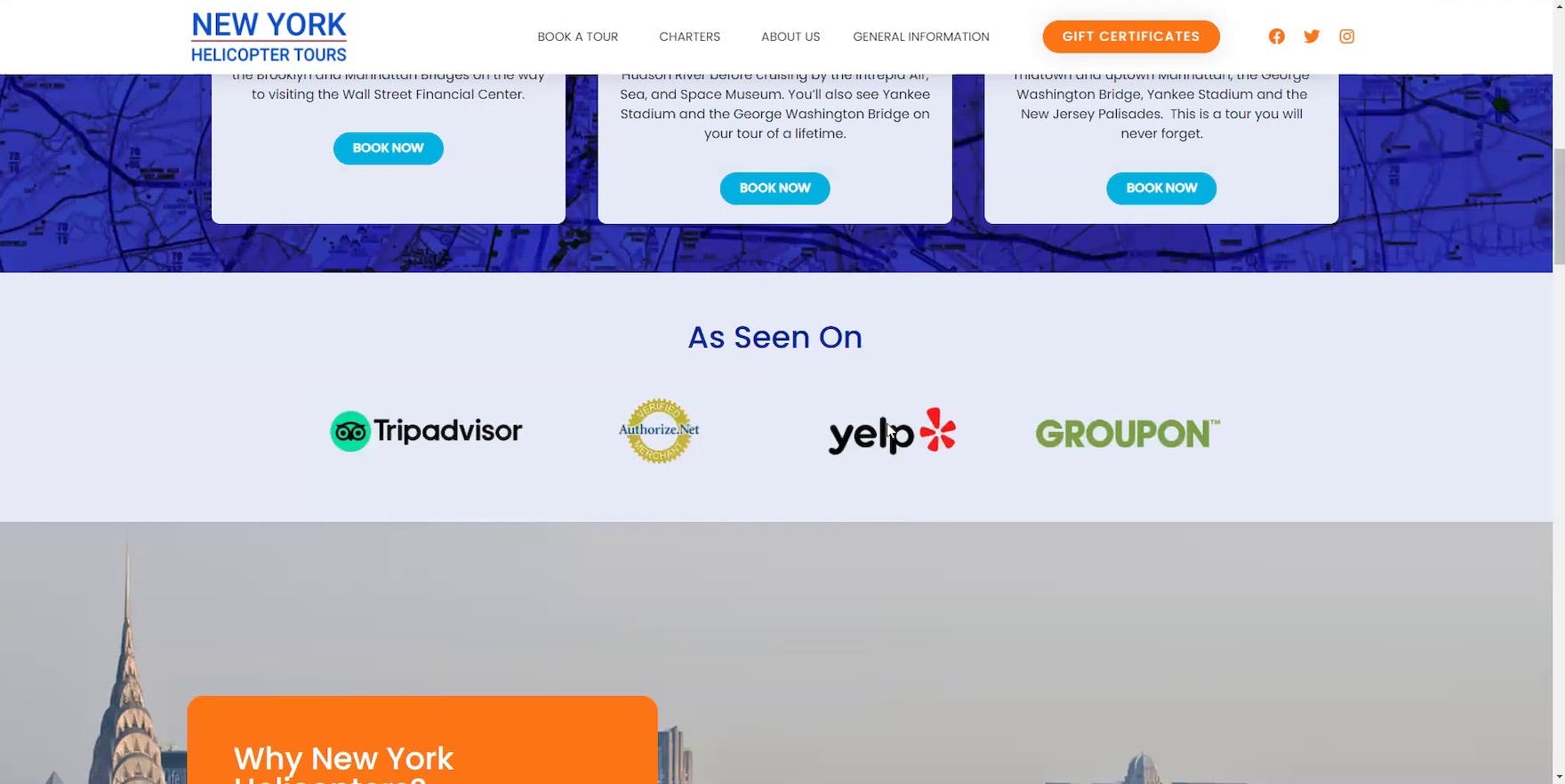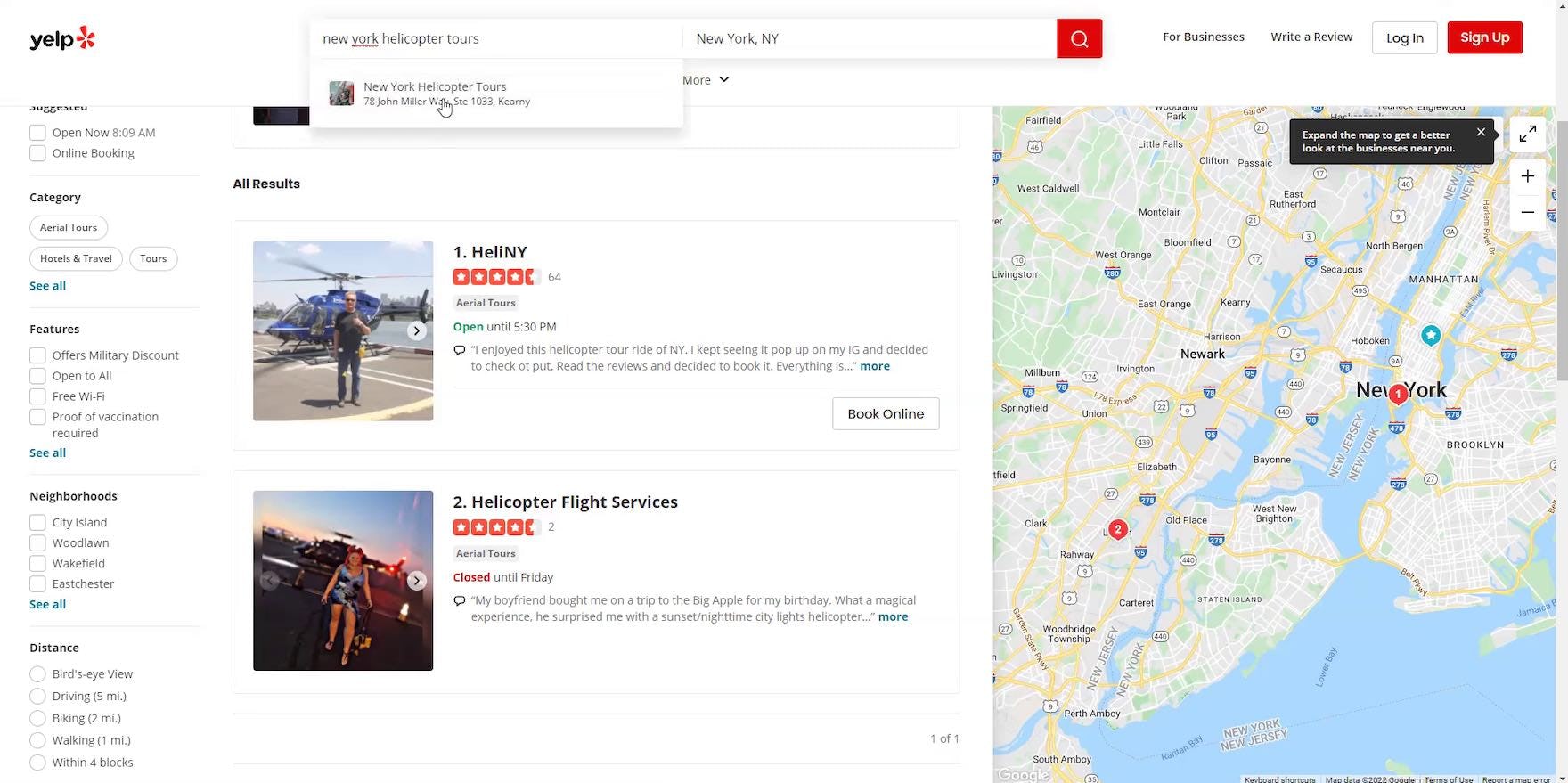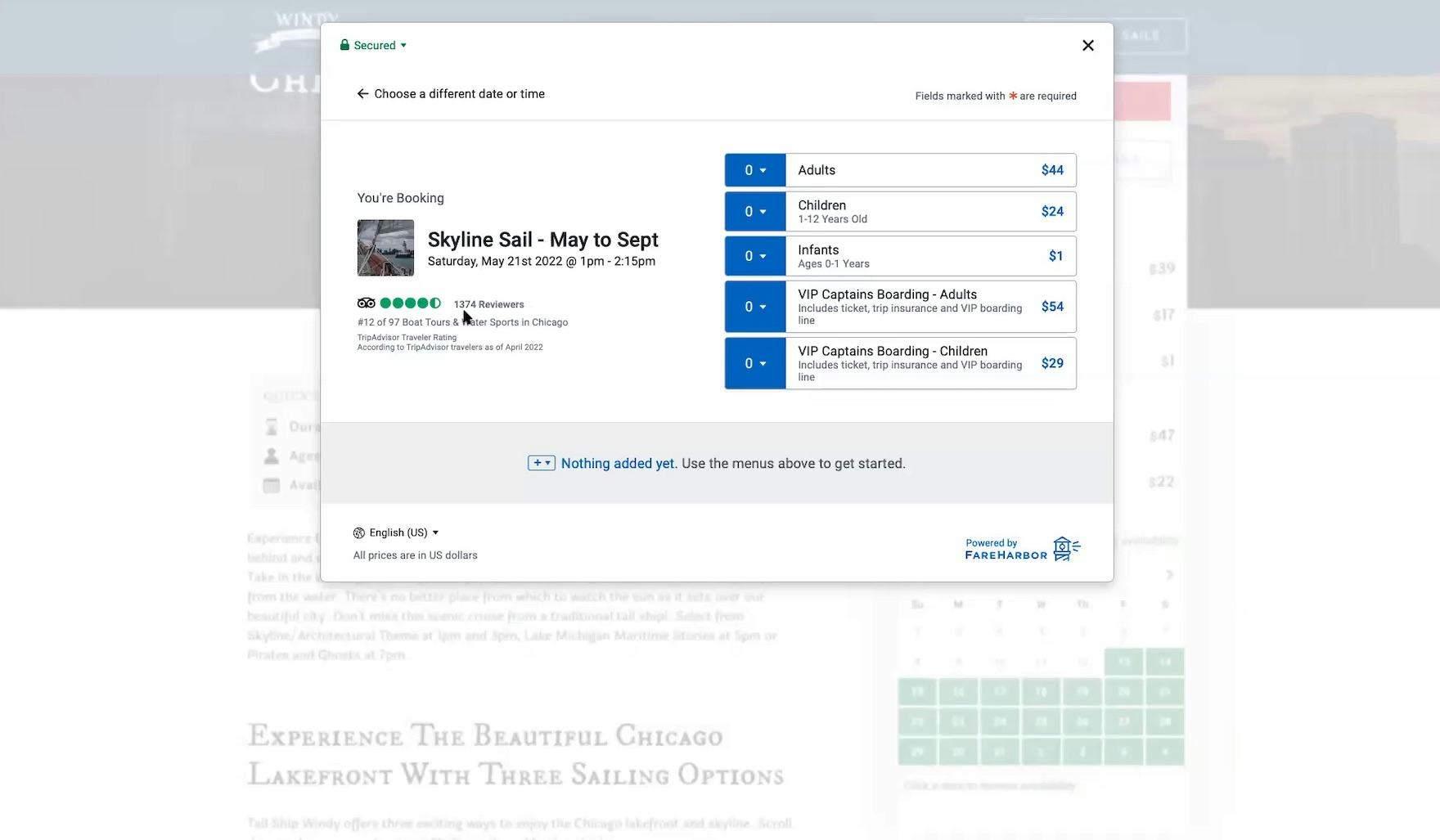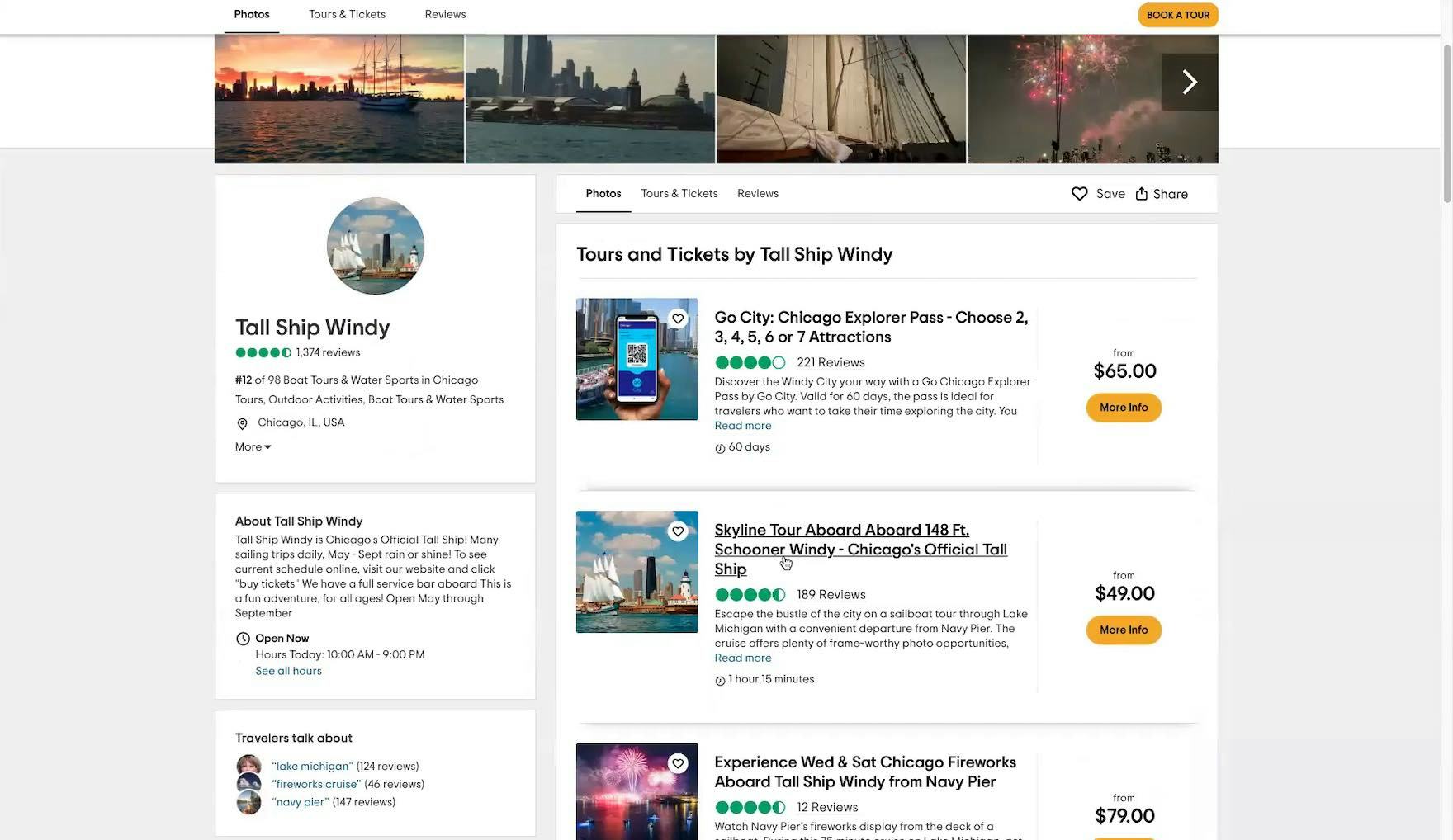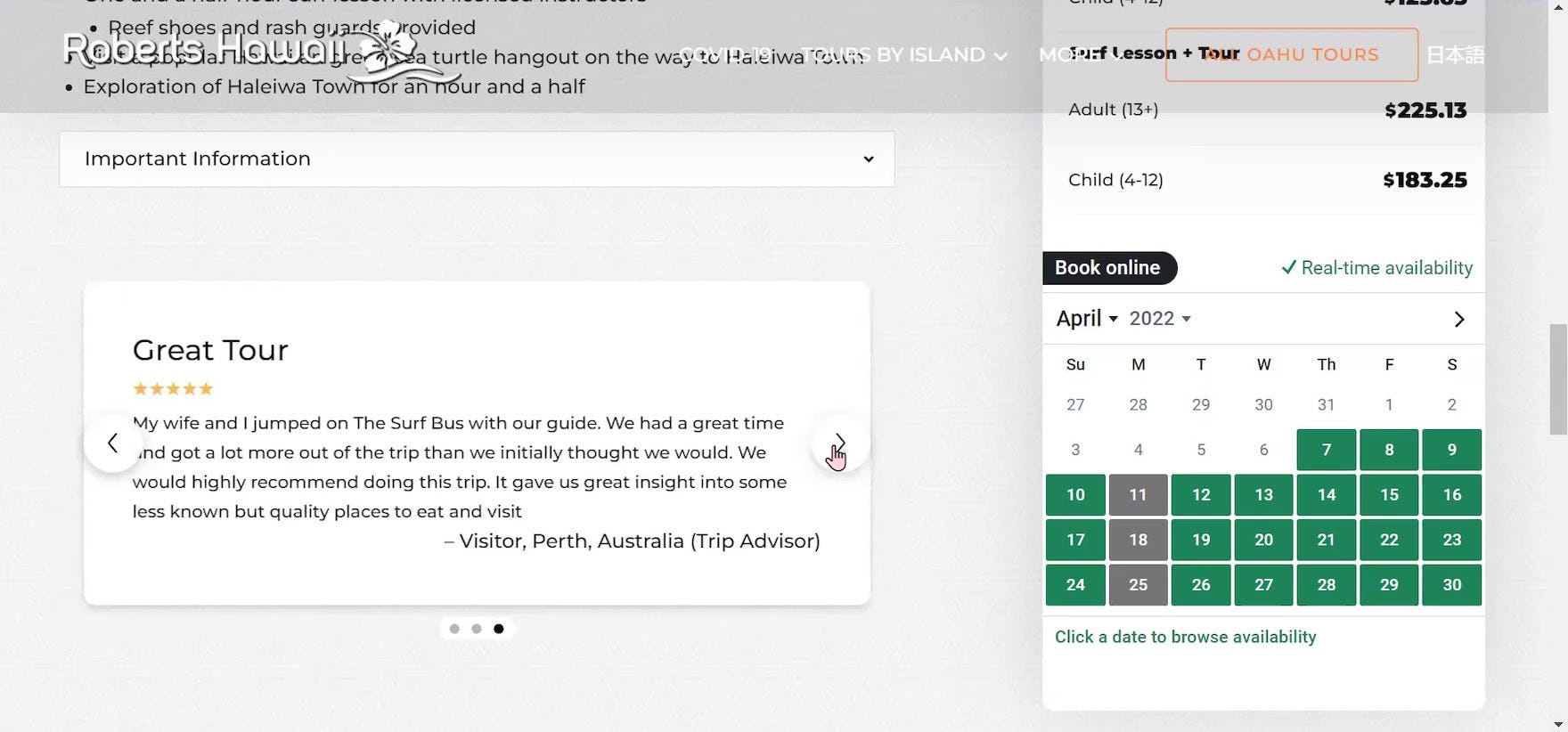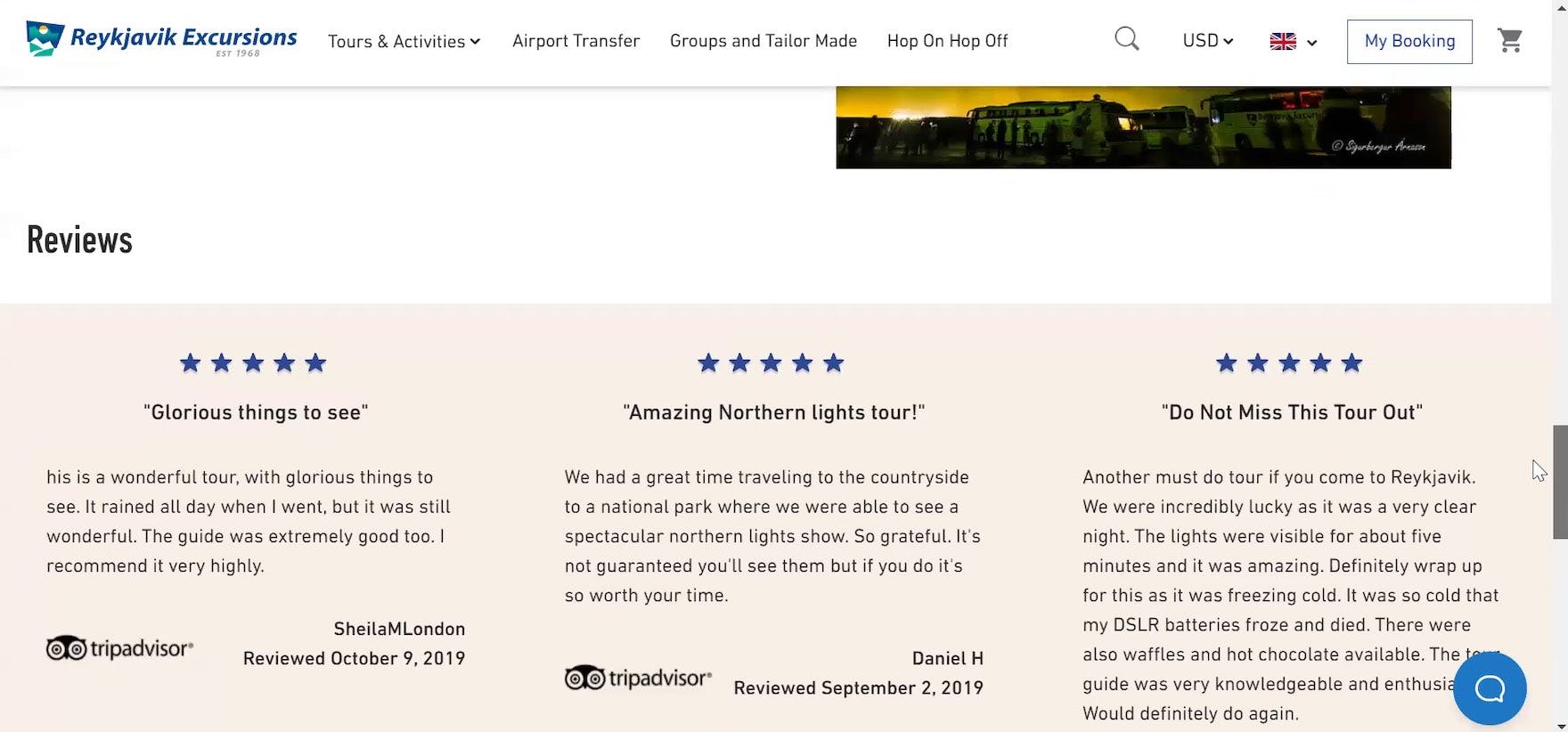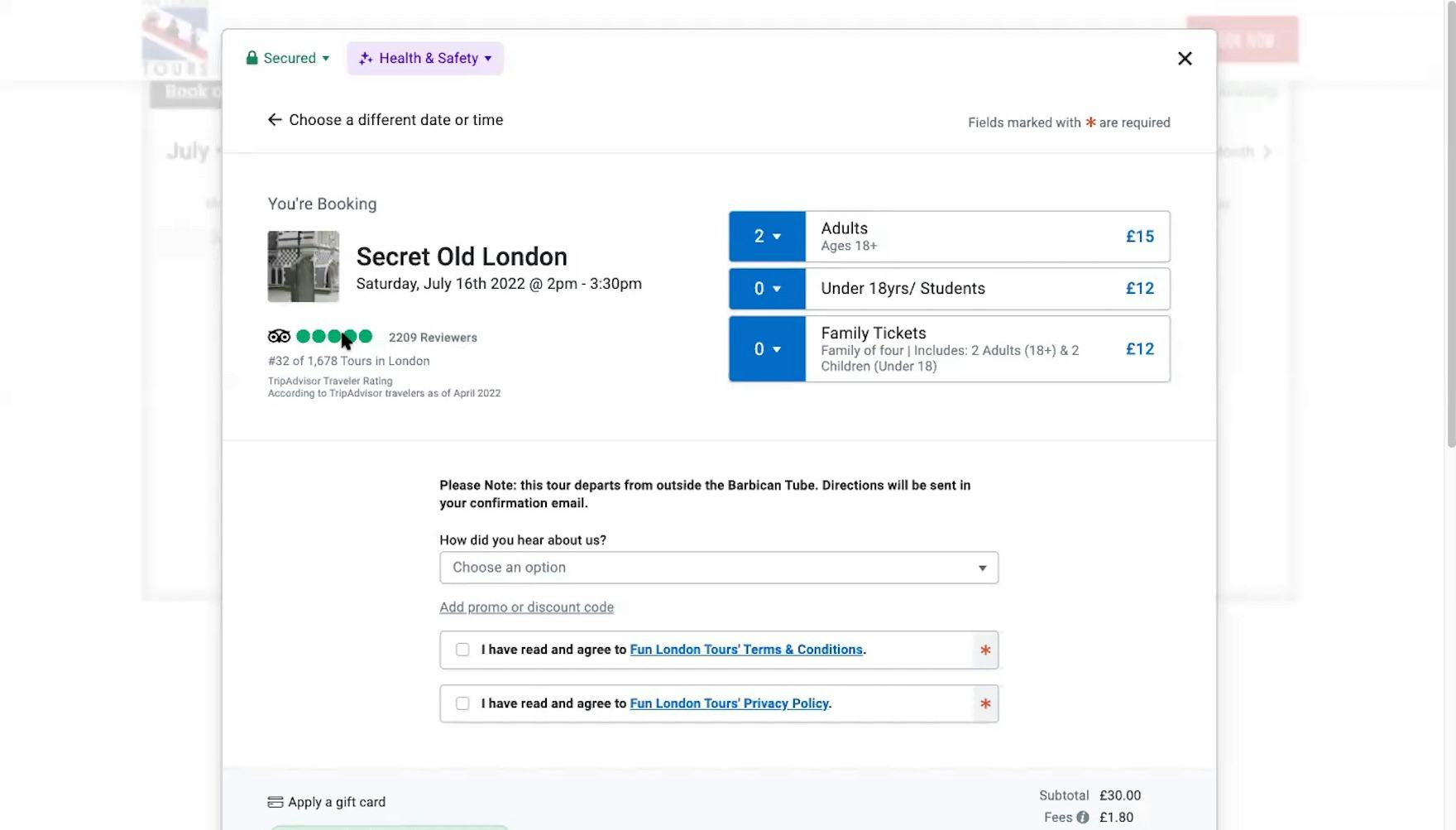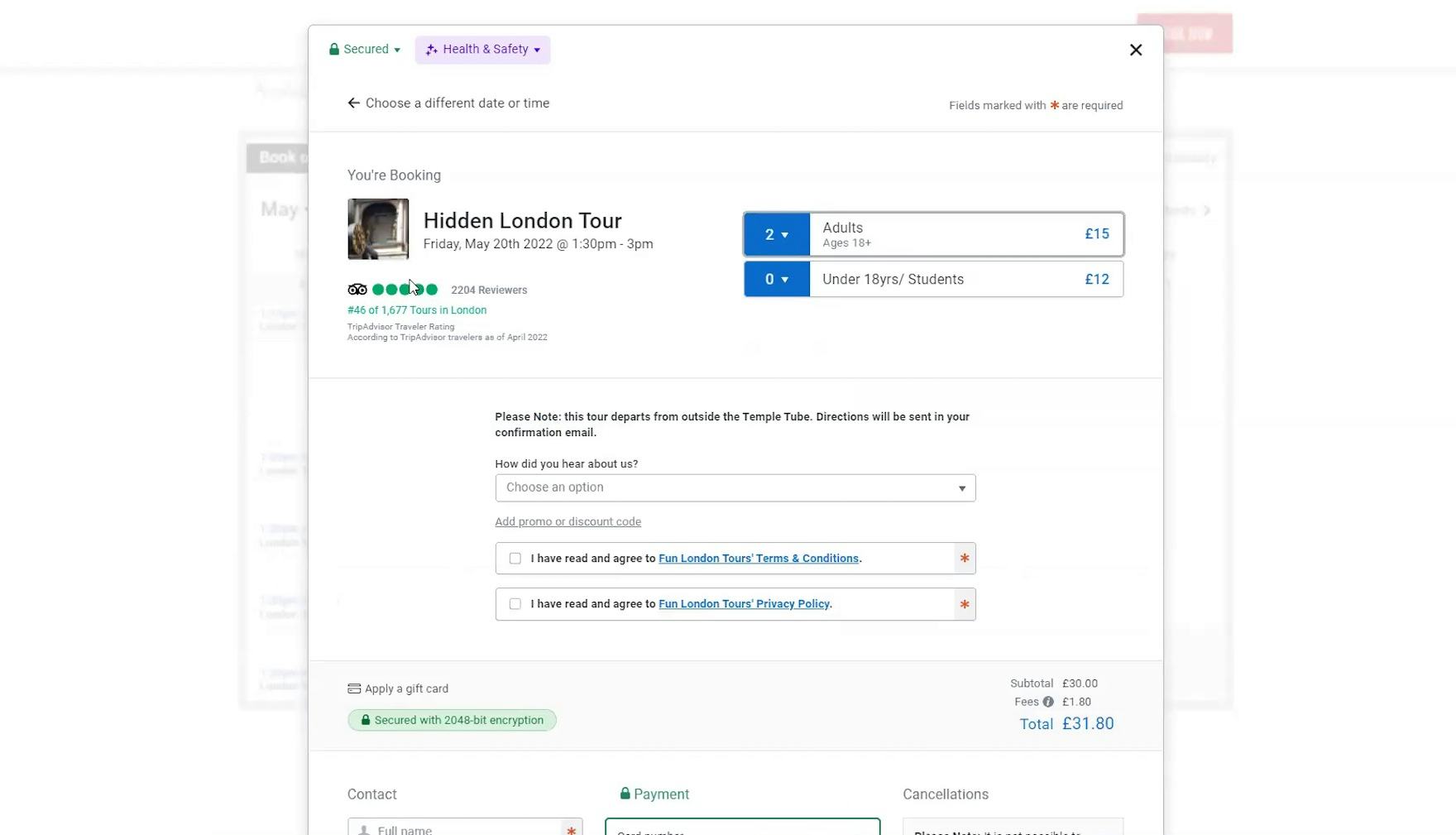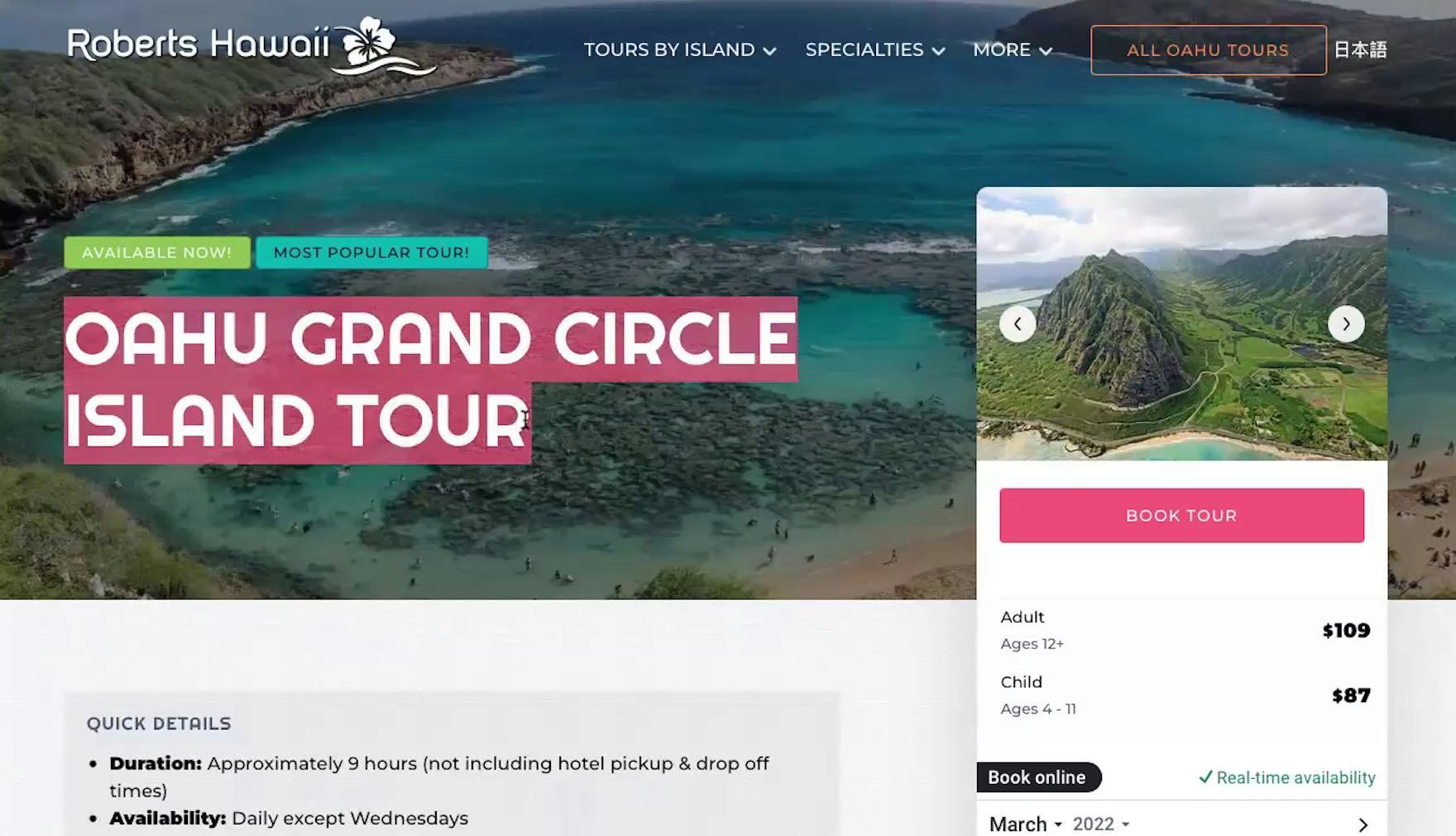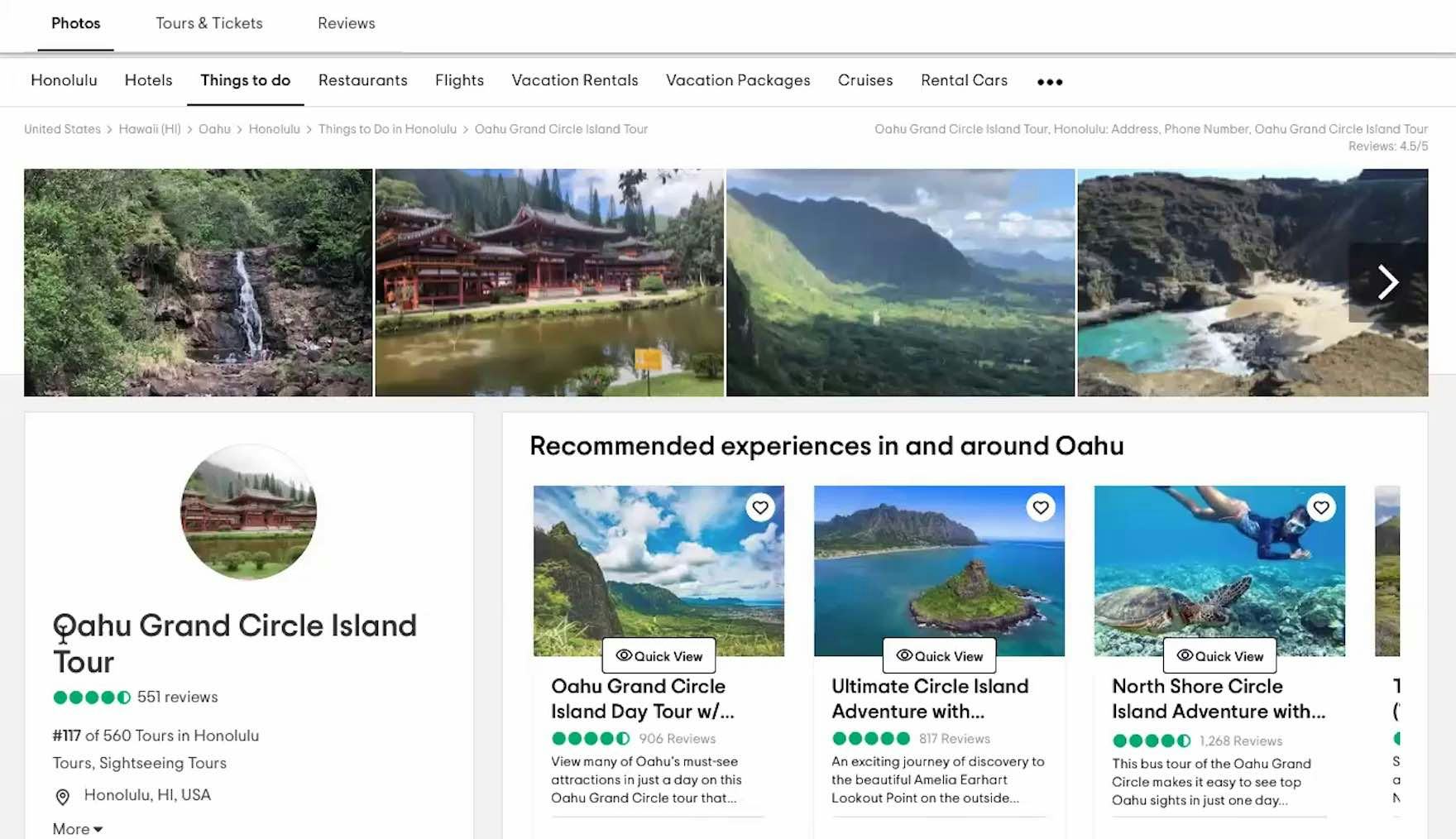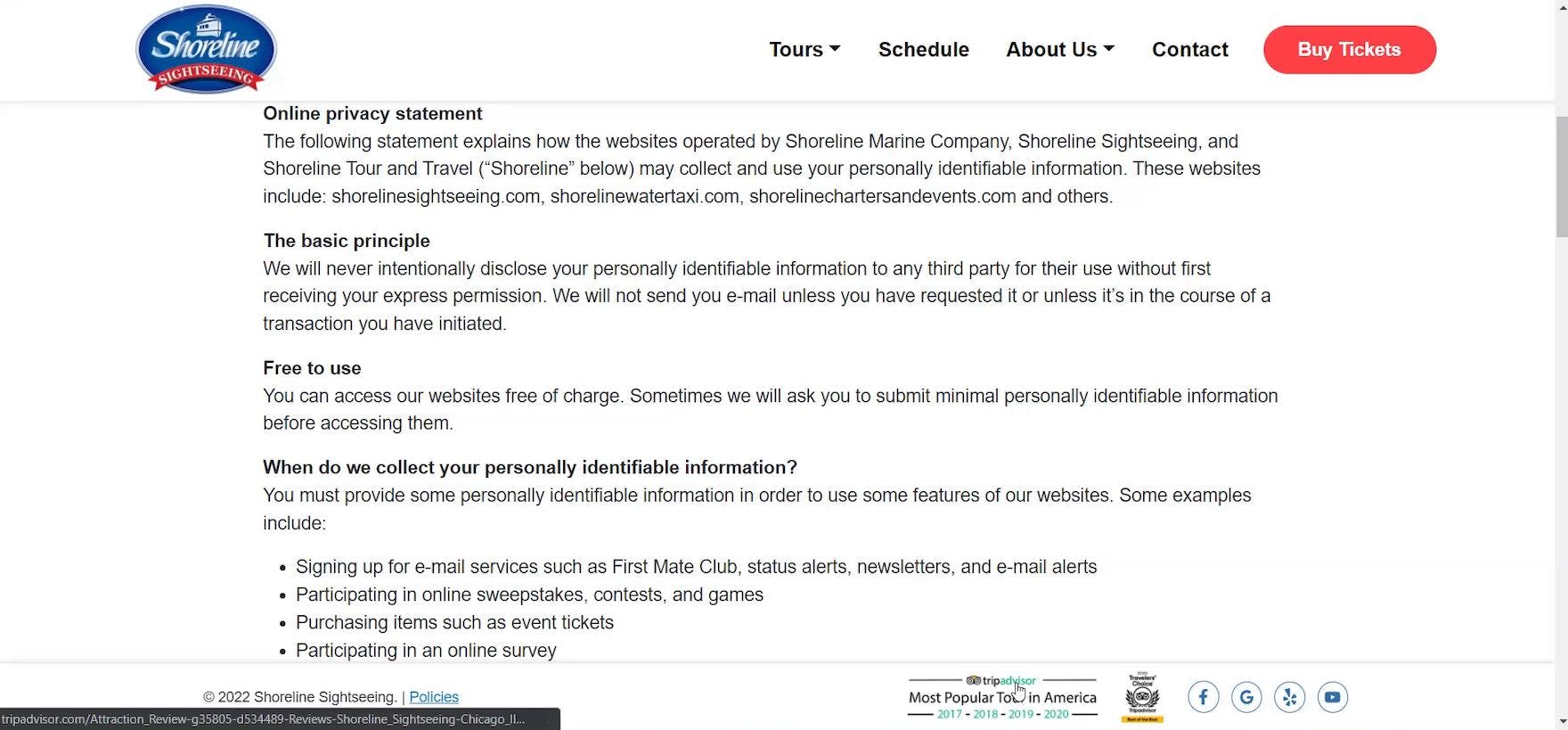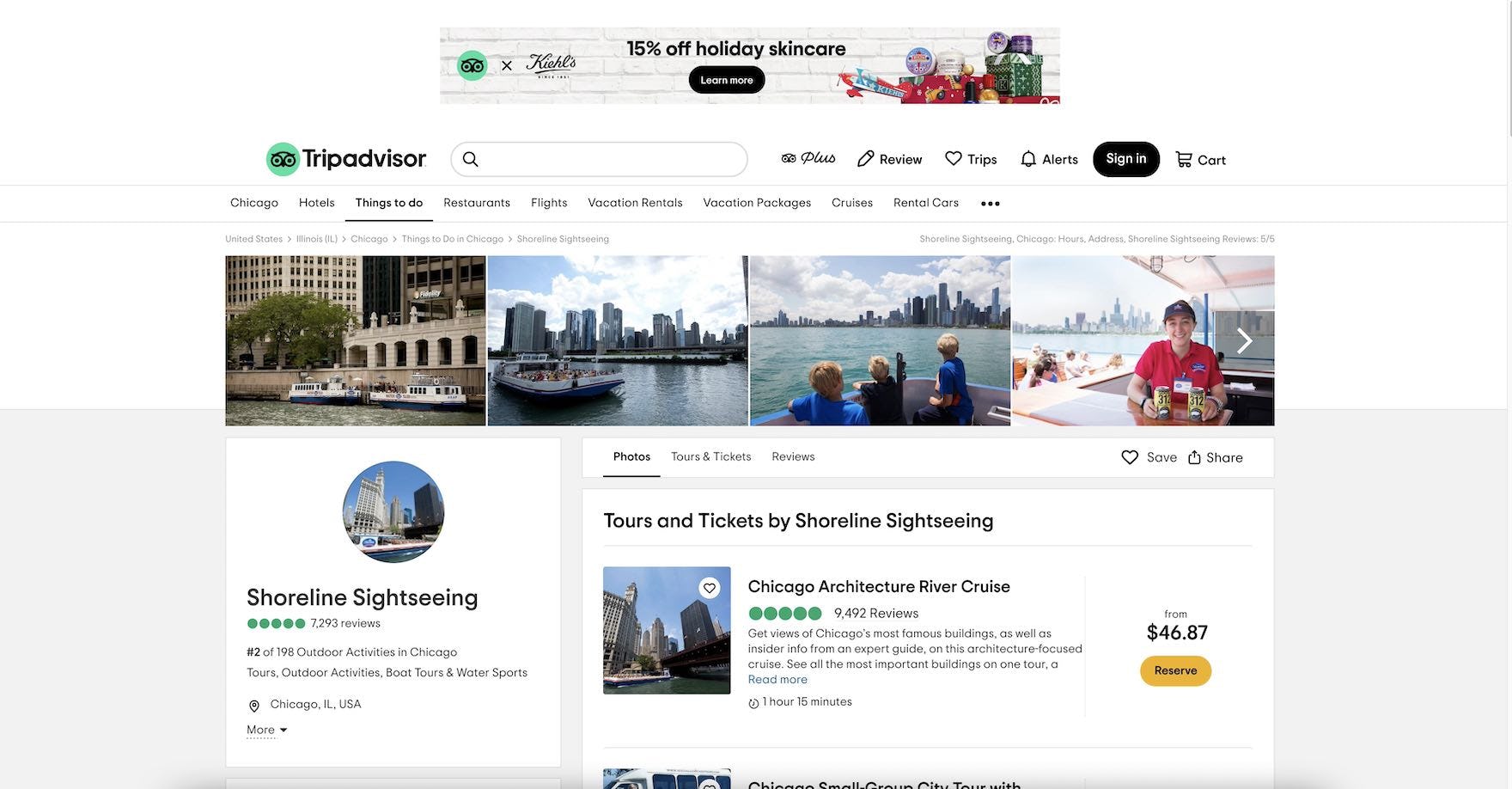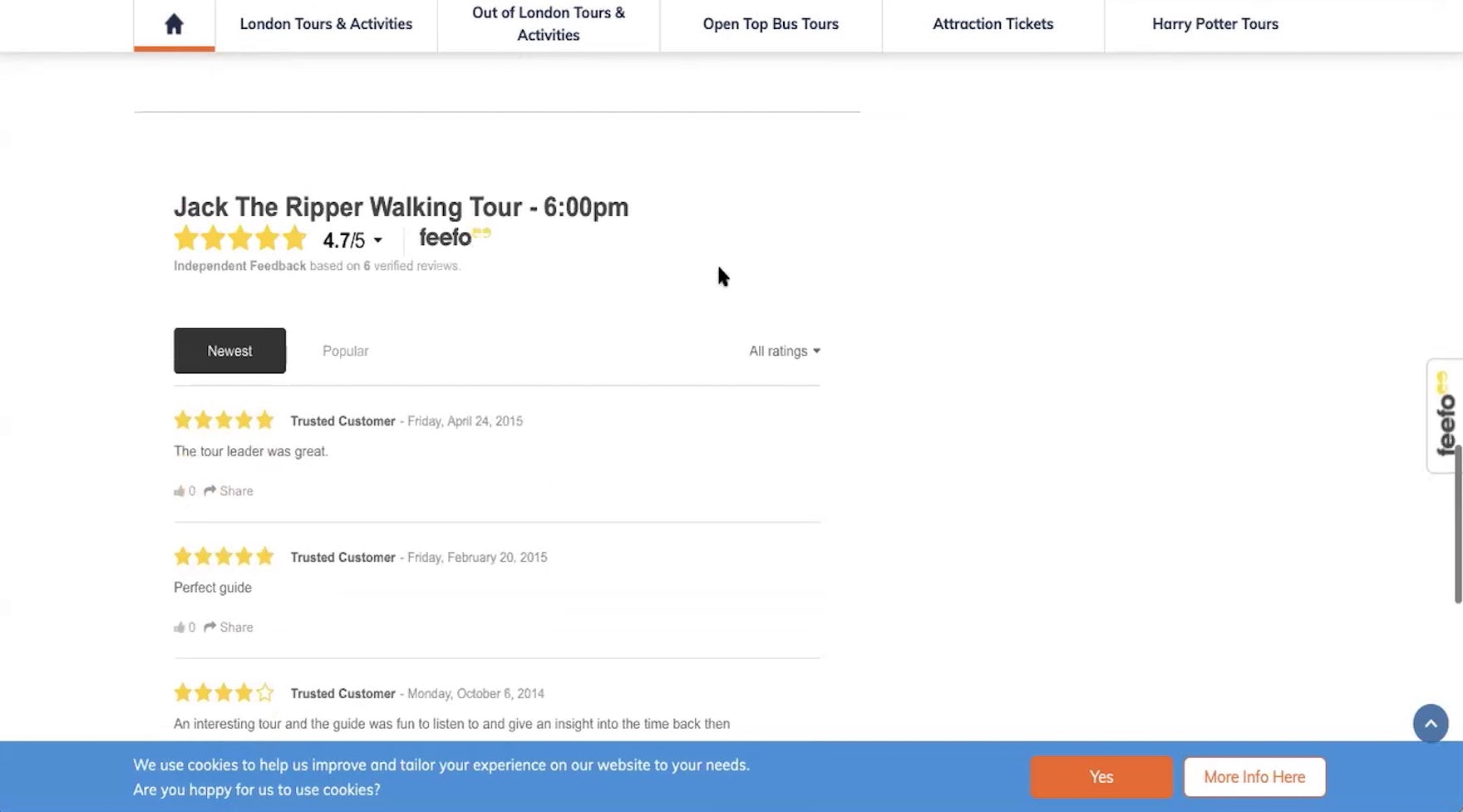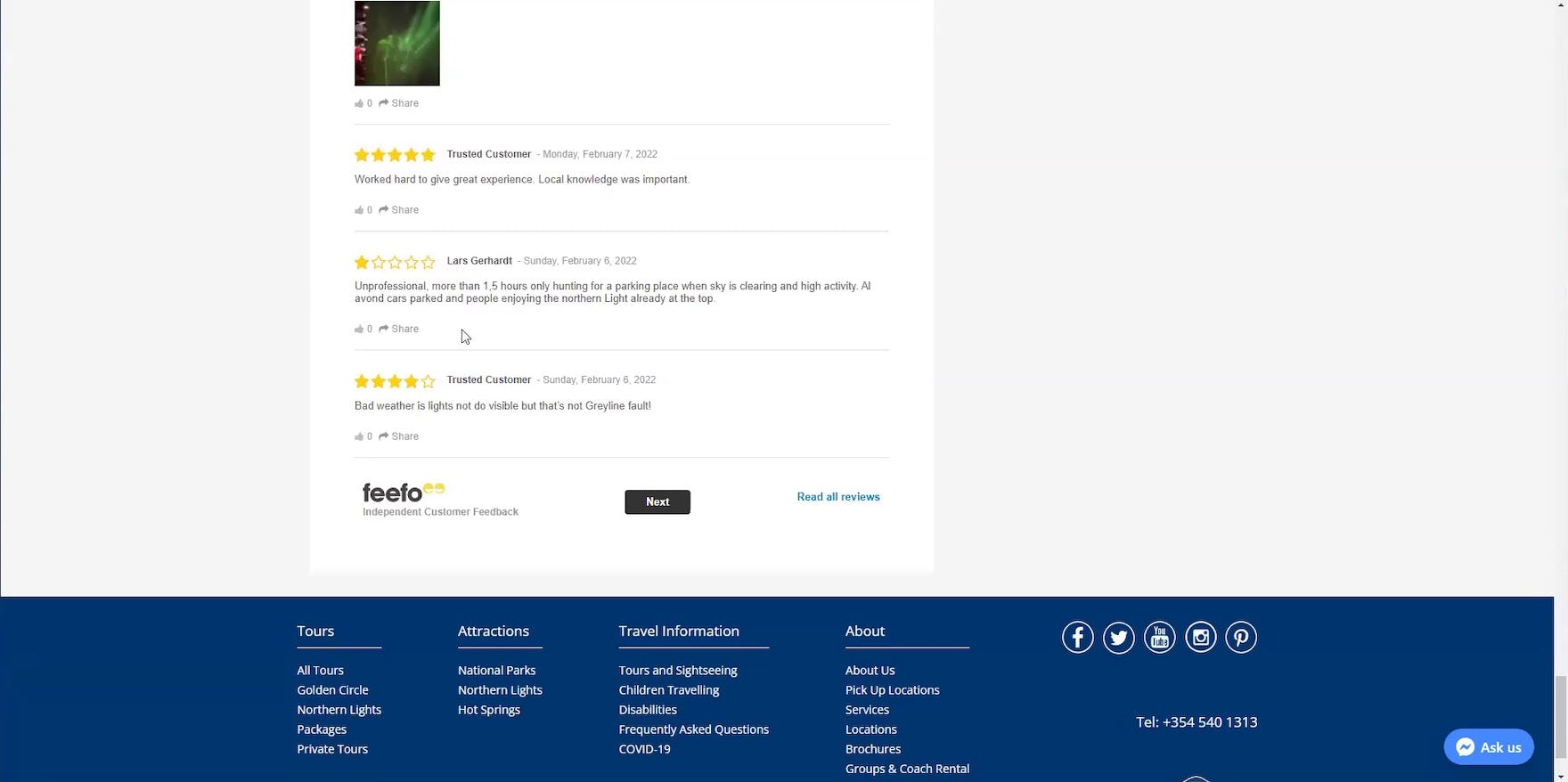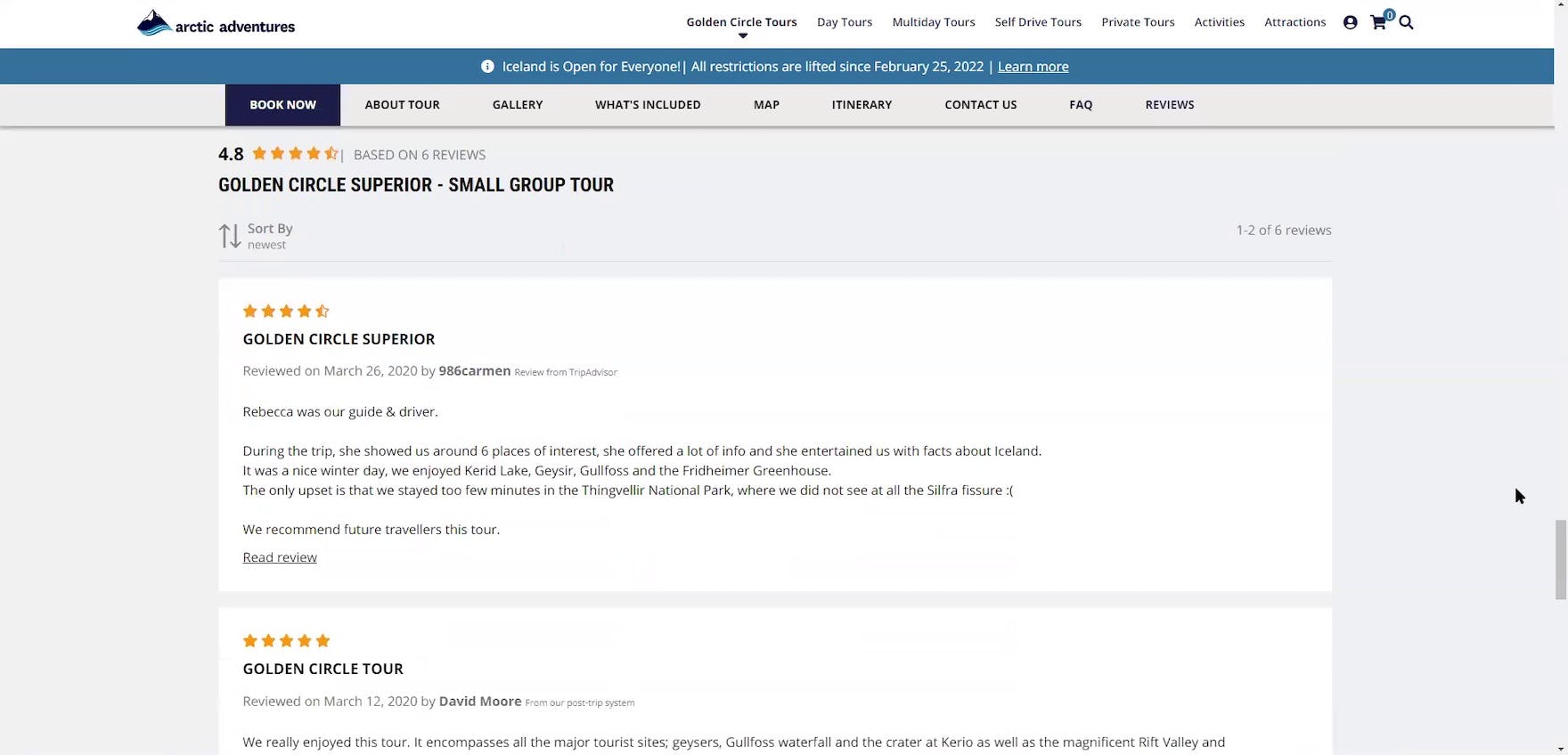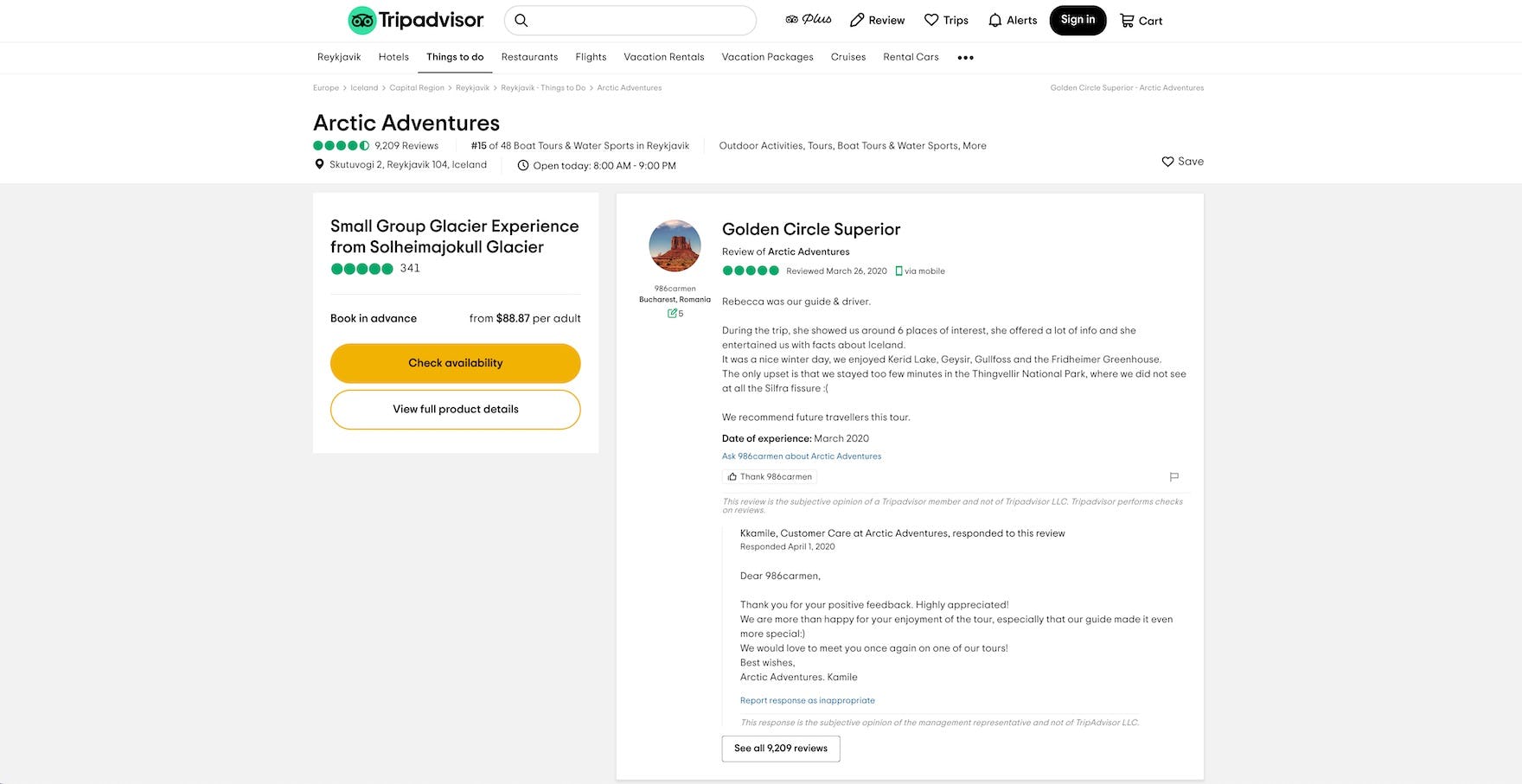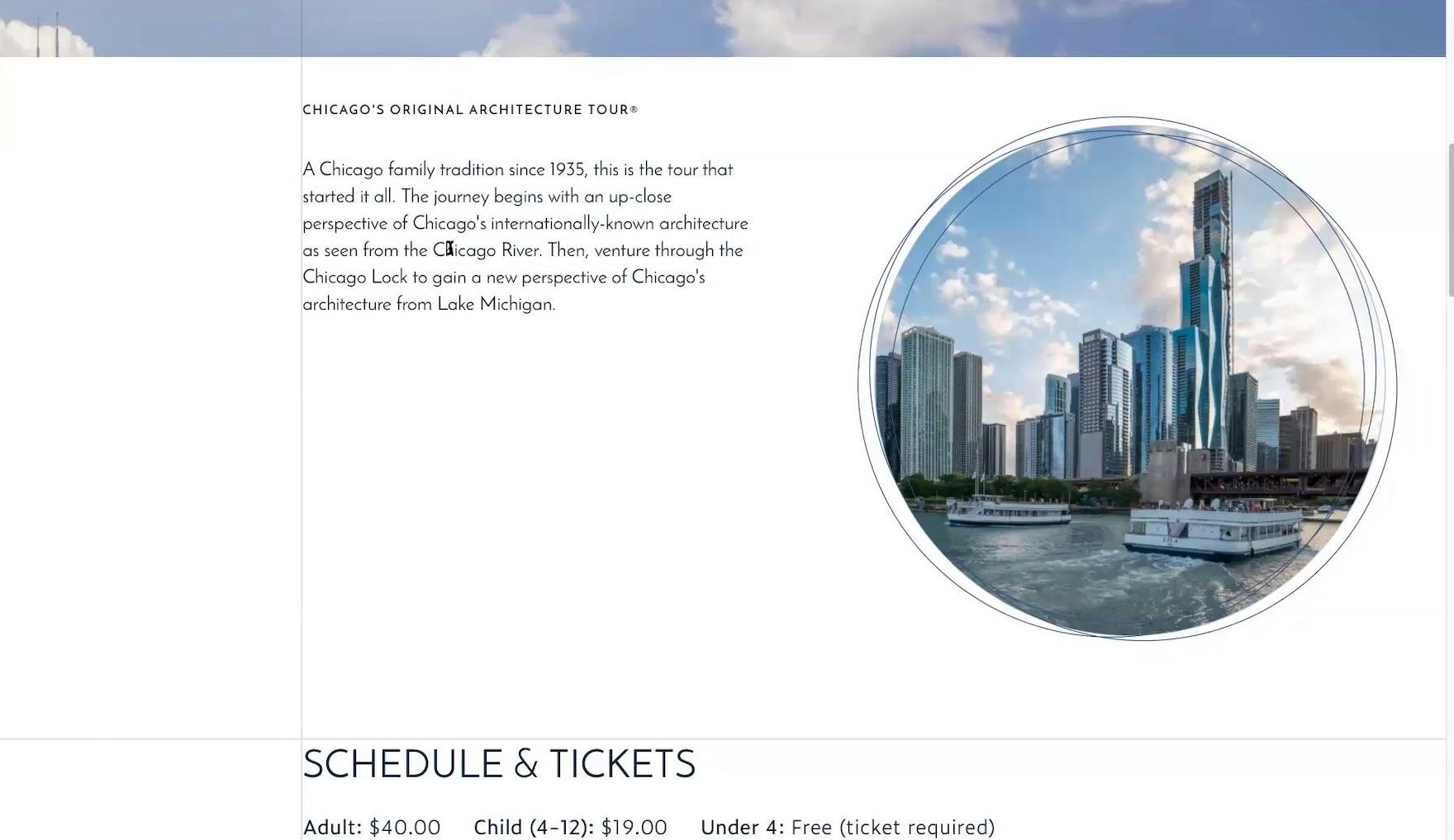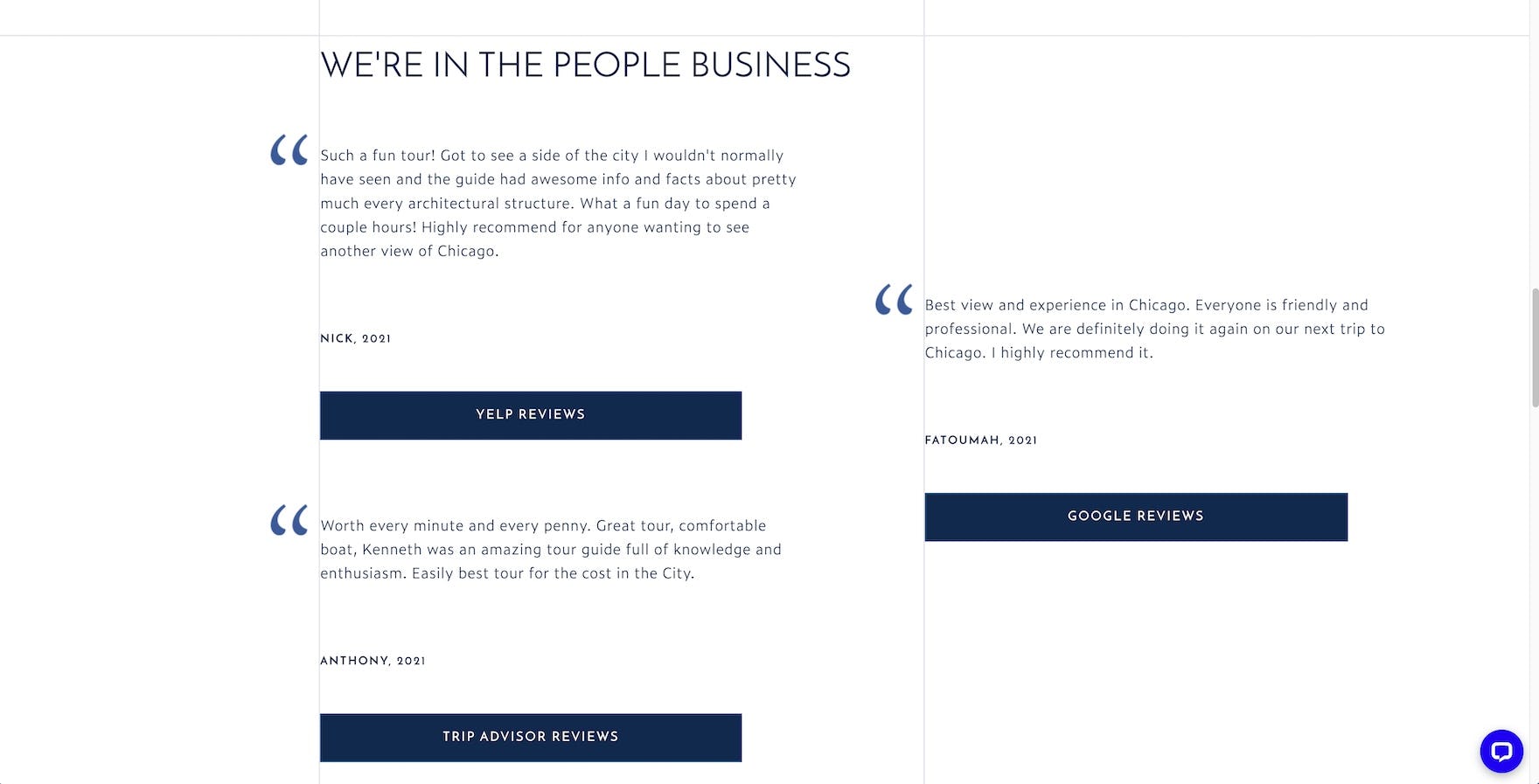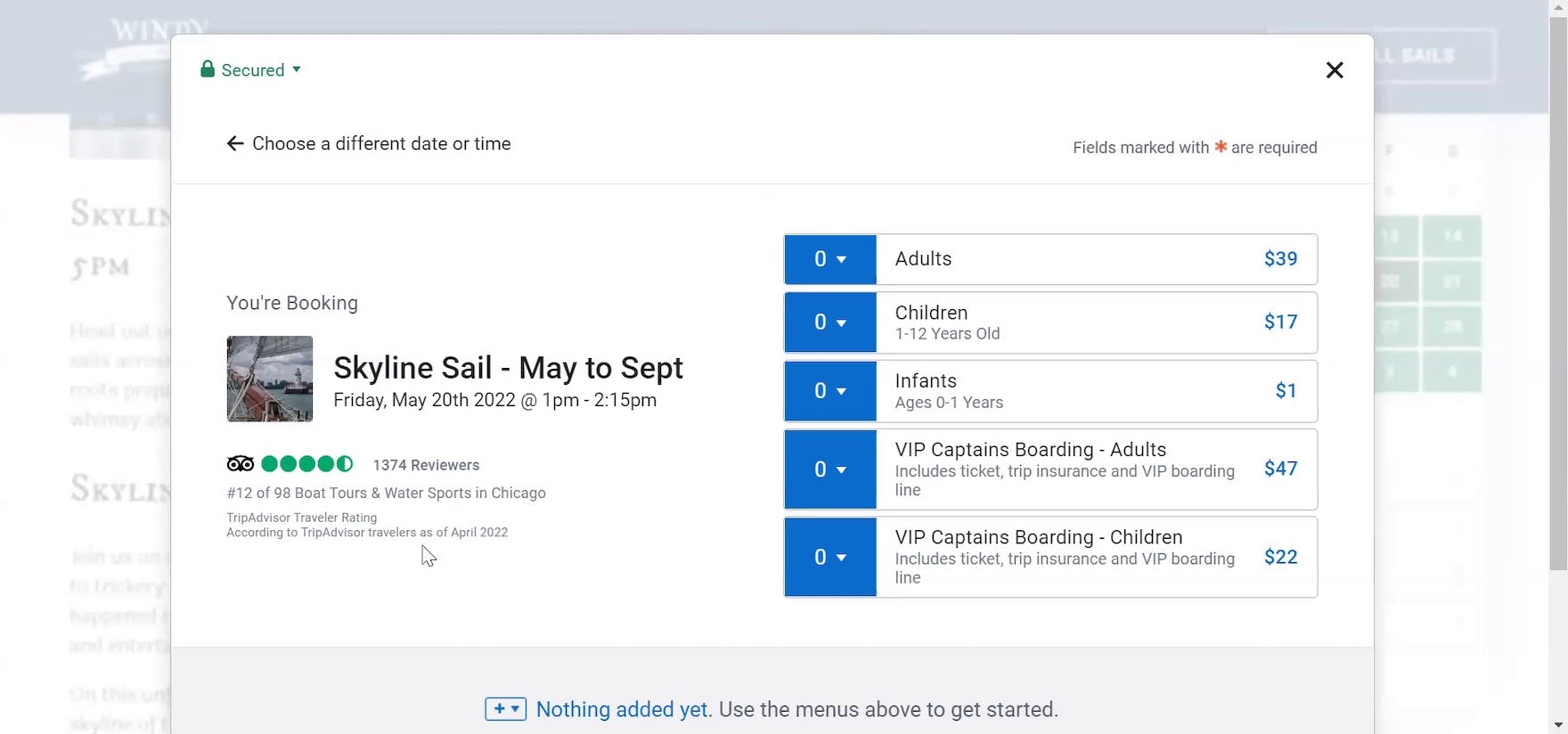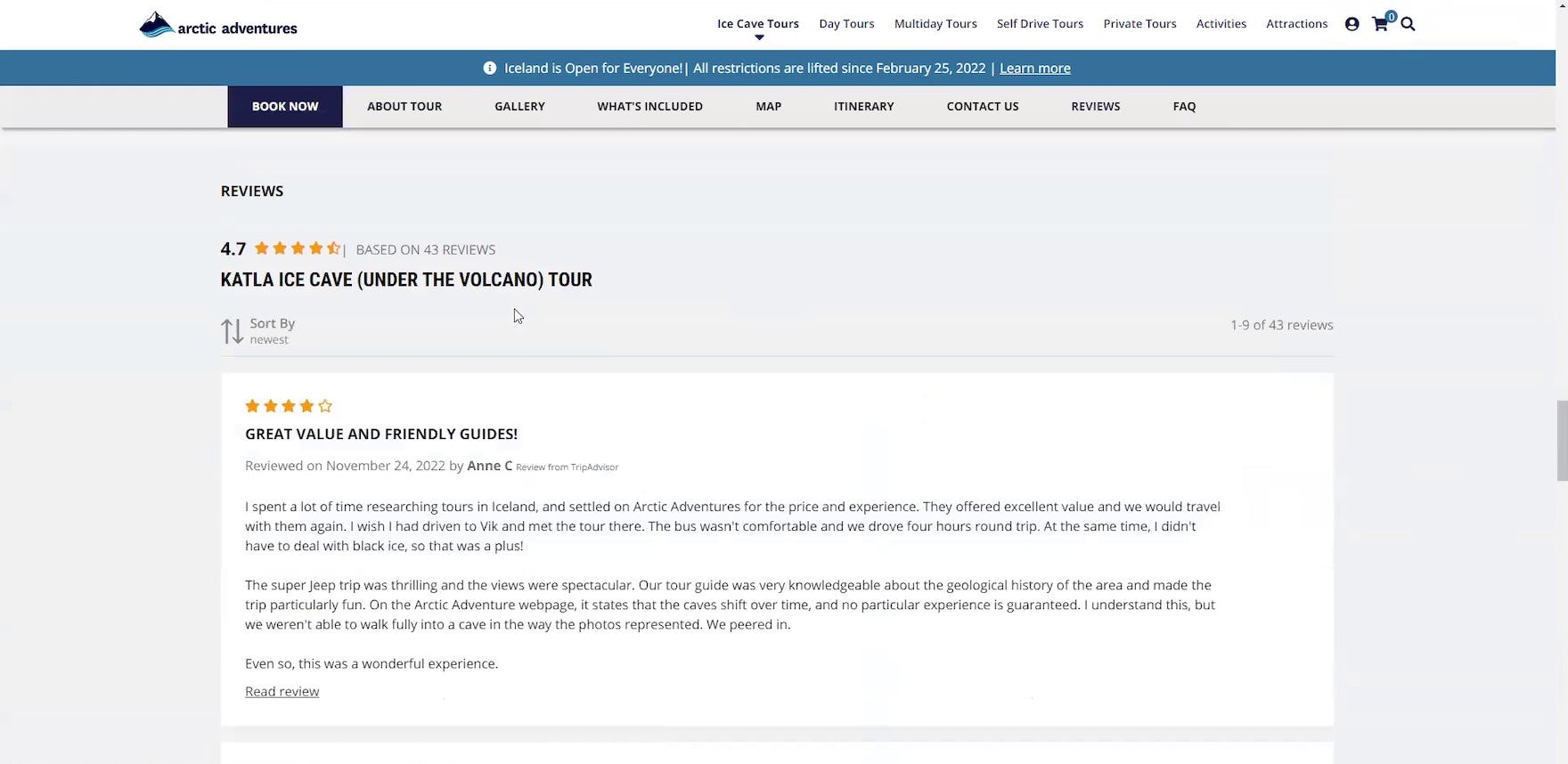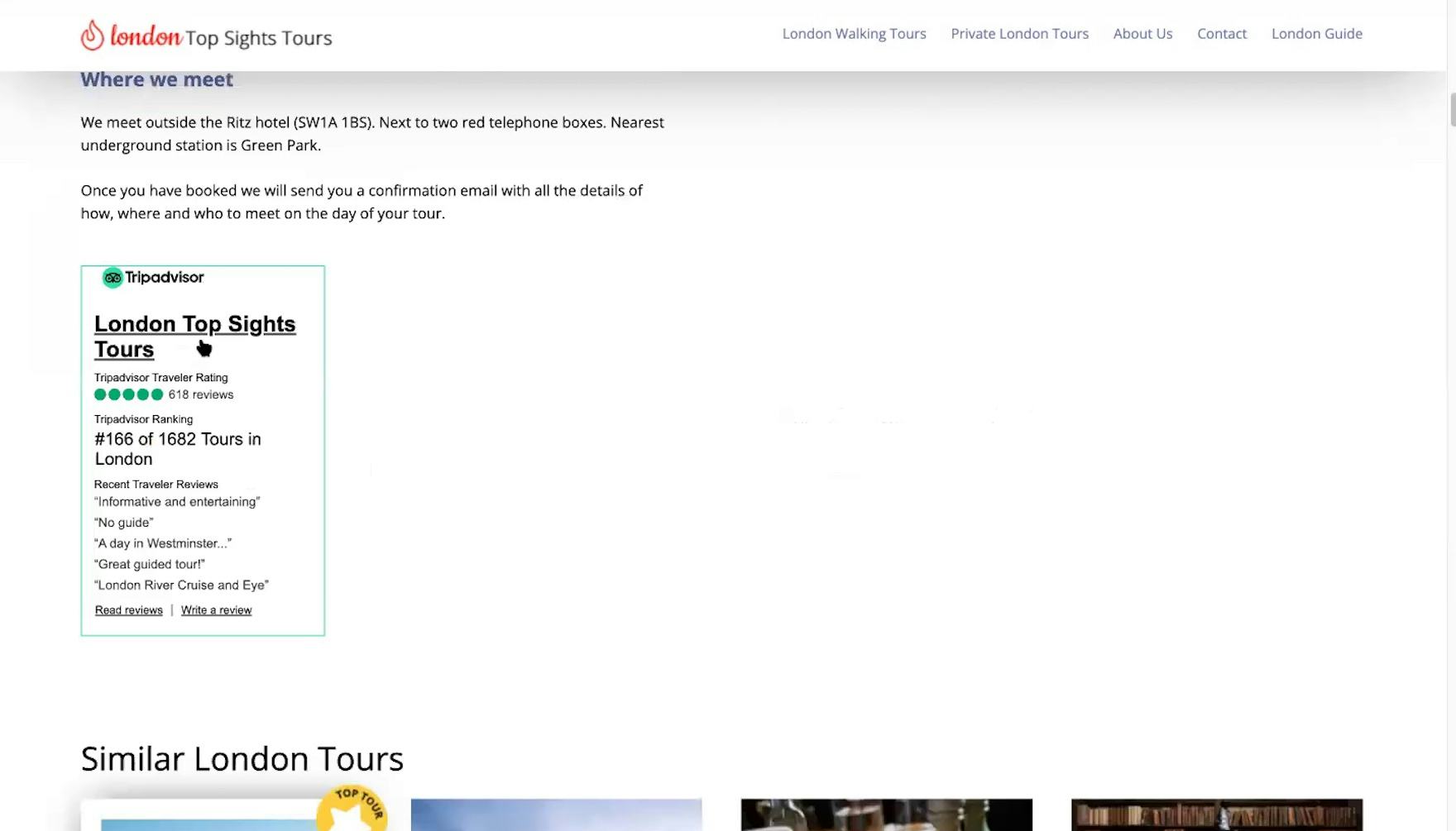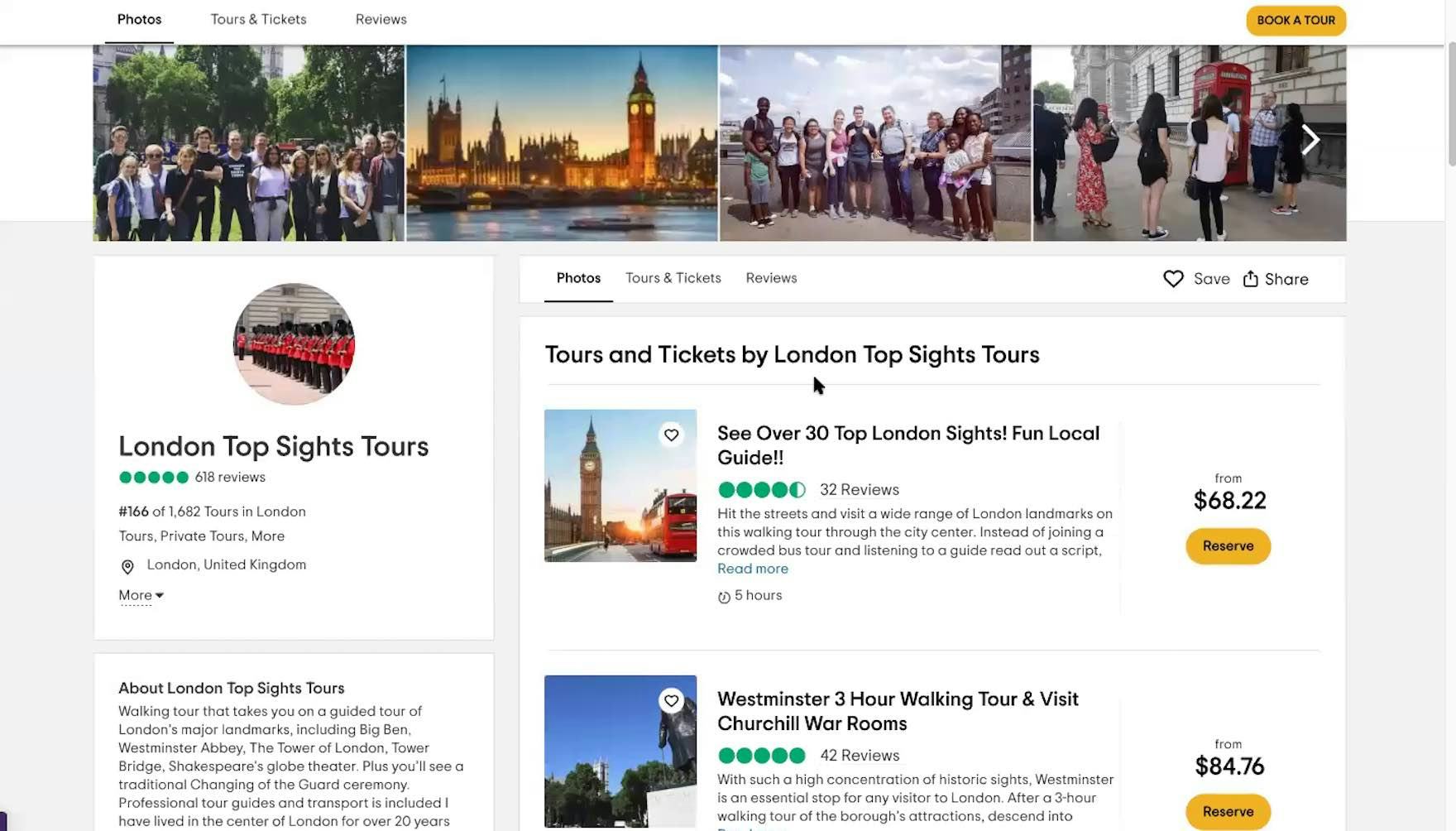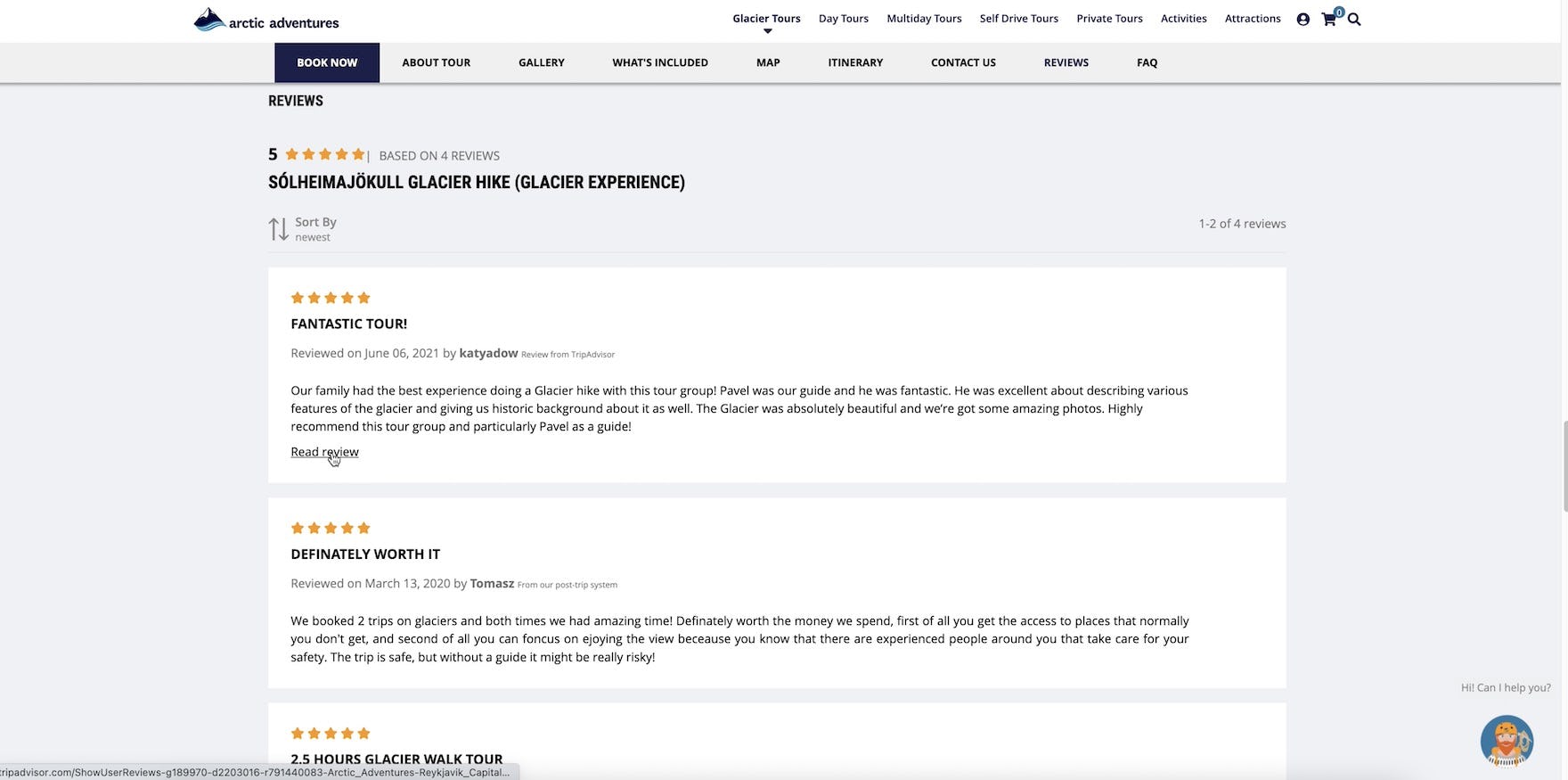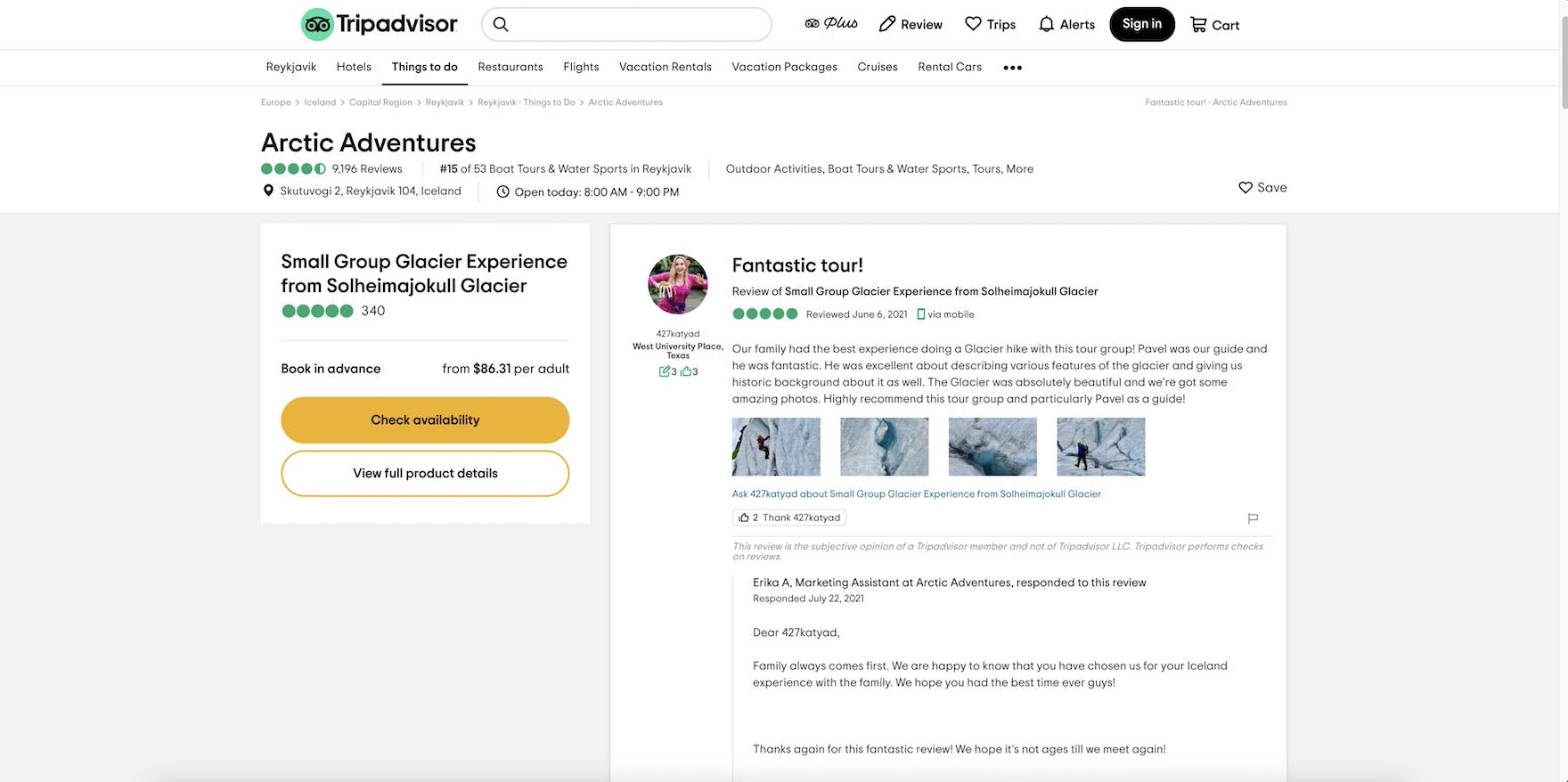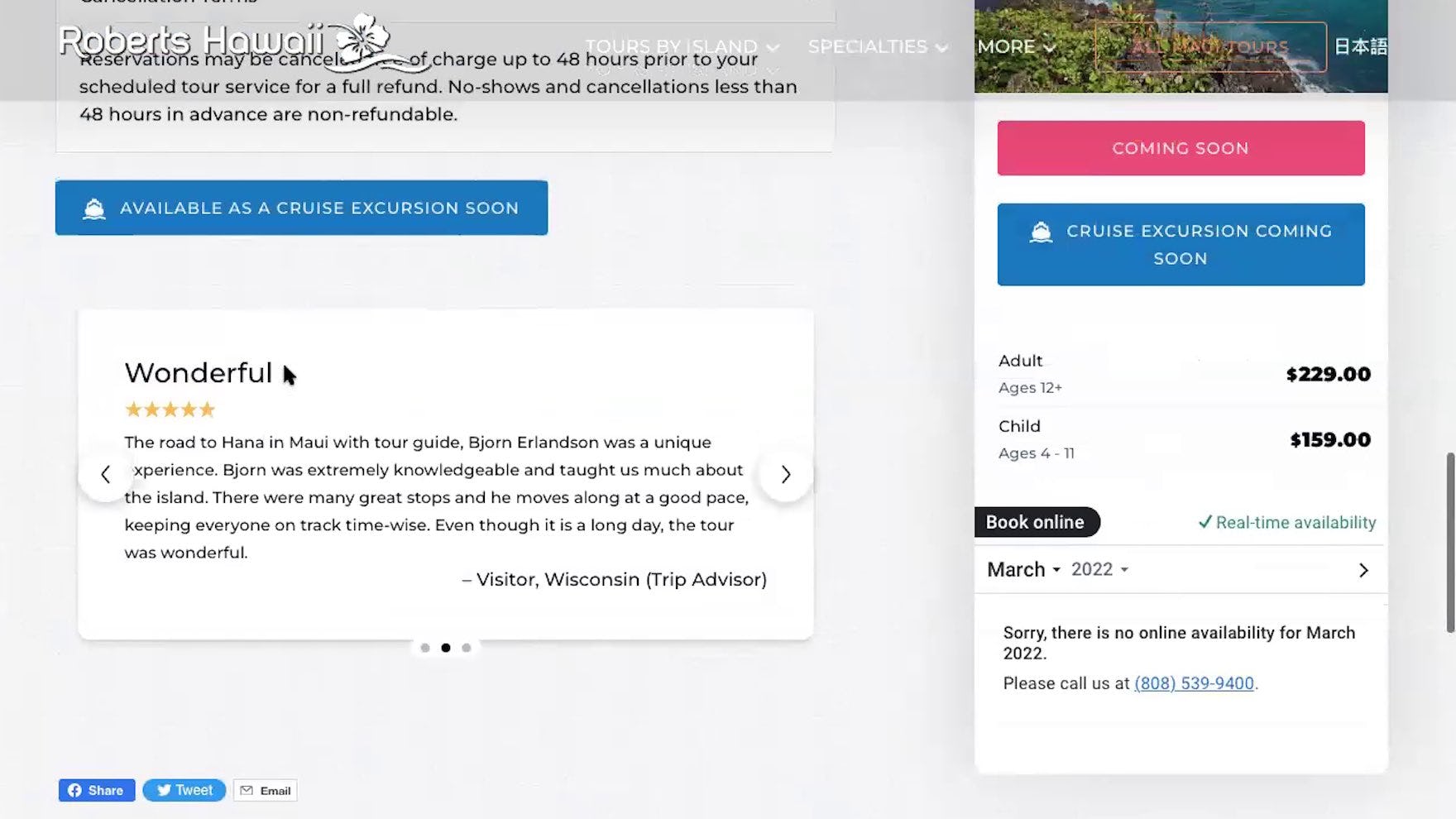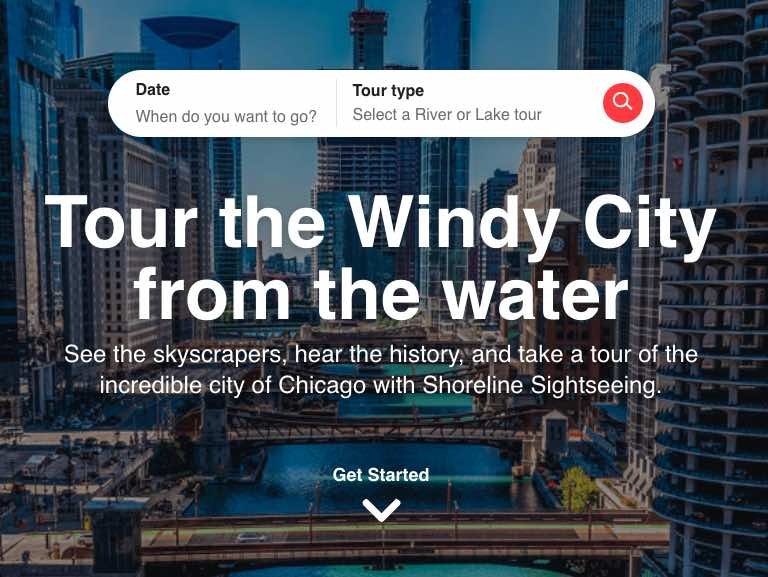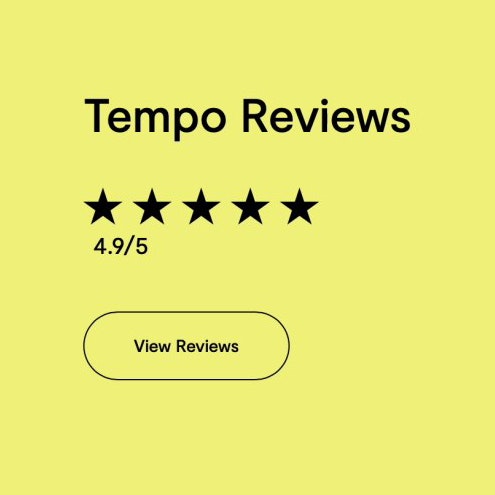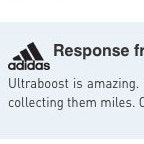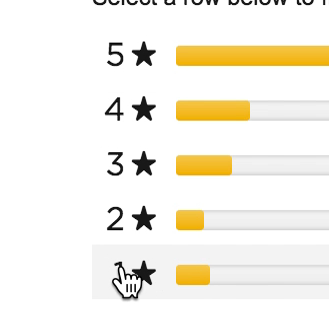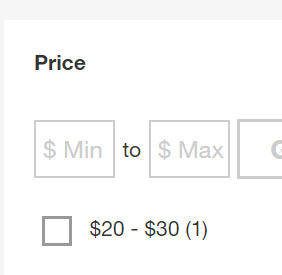Key Takeaways
- Users considering booking a tour or experience often need “social proof” in the form of user reviews to help them make their decision
- Yet large-scale testing revealed that many Travel Tours and Experiences Booking sites fail to provide desired review content
- Linking to or integrating third-party reviews on the Travel Tours and Experiences Booking site will meet most users’ needs for review content
“This is a big thing for me — seeing others’ reviews. I always like to hear what people say, whether positive or negative. That does typically have an impact on whether I’m willing or not willing to book.”
Users shopping for guided sightseeing tours and experiences are understandably interested in and heavily influenced by the opinions of others who’ve previously booked the particular tour they’re considering.
During Baymard’s large-scale testing of Travel Tours and Experiences Booking sites, most of the test sites attempted to address this desire for “social proof” by featuring third-party reviews, aggregate ratings, awards, and endorsements.
However, the integration of this third-party content often fell short of meeting participants’ needs, resulting in needless friction, lowered trust, and increased abandonment.
In this article, we’ll discuss our Premium research findings on reviews for Travel Tours and Experiences Booking sites:
- Why testimonials aren’t enough
- Why superficial “stamps of approval” from third-party sites aren’t enough
- How to integrate third-party reviews on the tours and experiences site to satisfy user needs
- 2 implementation details to get right when integrating third-party reviews
Why Testimonials Aren’t Enough
“I never read the testimonials on a website. I think it’s a pointless waste of space because, of course, they’re going to just put whatever nice things that they would say.” A participant at HeliNY dismissed the curated testimonials featured on the homepage outright, perceiving them to be too biased.
“Here I see testimonials, which, usually to me, I don’t really read on their main site because it’s nice that they have them, but obviously they can pick which ones they want to put on there as opposed to a third-party website”, explained a participant at New York Helicopter Tours.
To satisfy users’ need for reassurance from others about a tour or tour operator, a few of the test sites featured a curated selection of site-provided testimonials from satisfied users, likely solicited directly after taking a tour.
However, as observed during testing, a subgroup of users will be highly skeptical of these glowing reviews and simply ignore them.
As one participant remarked, “Testimonials are kind of like, everybody is happy about it. So, does it mean that they don’t have any bad reviews, or does it mean that they are only including the good reviews here?”
In practice, a curated selection of site-provided positive testimonials simply lacks credibility, and many users will be uncomfortable relying on only testimonials when making a booking decision.
Note that a similar user skepticism exists for small catalog, direct-to-consumer sites, where participants during testing were similarly skeptical of reviews.
In the end, while testimonials are fine to provide on a tours and experiences site, they won’t be enough by themselves to persuade most users.
Why Superficial “Stamps of Approval” from Third-Party Sites Aren’t Enough
Next, some sites during testing went beyond curated testimonials and provided third-party “stamps of approval” (e.g., by displaying logos for “Yelp”, “Tripadvisor”, etc.), ratings averages, (e.g., “Rated 4.8 out of 5 on Tripadvisor”), or a handful of often timestamped third-party reviews.
While seemingly an attempt to provide more trustworthy “social proof”, participants during testing were observed clicking on the third-party content in an attempt to reach the underlying reviews — yet on many sites the content was only static and limited.
Consequently, a subset of participants left the site and navigated to the third-party website to manually search for the tour in order to read the underlying reviews.
“I would go to Yelp and take a look at this website. I saw they had something here — where is it? It had a link to Yelp. Okay, here. Oh, it doesn’t link.” A participant at New York Helicopter Tours tried to click the Yelp logo featured in the “As Seen On” section of the homepage (first image), but when nothing happened, she had to search for it manually (second image).
“It looks like there are quite a few reviews on this, which is, I mean, that’s a good high rating. How do I? It doesn’t — interesting — it doesn’t let you actually go into that. I’d want to be able to actually click through on this”, complained another participant at Tall Ship Windy as he tried to click on the “Tripadvisor Traveler Rating” in the “Booking” overlay (first image). He opened another browser tab and manually located the tour operator and then the tour at Tripadvisor (second image).
“Okay, so they only have a couple of reviews. That’s kind of a deterrent for me. I’d like to read more reviews to get a more broad spectrum of people’s feedback”, complained a participant at Roberts Hawaii, clicking through the carousel of curated Tripadvisor reviews. Deterred from exploring tours due to a lack of access to the full range of reviews, she eventually abandoned the site.
“It bothers me that there are only 3 [reviews]. I’m trying to see if there is a way to see more, and I don’t see that. There could be more reviews. Since these are Tripadvisor, I’d probably go there and take a look”, explained a participant at Reykjavik Excursions. Testing revealed that some users will not be satisfied with only a handful of reviews, even when they are sourced from a well-known third-party site.
In practice, displaying “approval stamps”, ratings, or a selection of reviews from third-party sites — without providing access to the underlying reviews — can backfire.
Instead of reassuring users about the quality of the tour or tour operator, such implementations were often observed during testing to negatively affect users’ perception of the site’s overall credibility.
Indeed, as one participant abandoning a site complained, “I wouldn’t spend much more time on it because this [site] just doesn’t seem legit. I mean, all [the tours] are 5-stars — and you can’t even click on [the rating]! That seems highly unusual. I would not go any further”.
Or as another stated, while also abandoning, “It concerns me when you have only a few reviews. I feel like it’s site-controlled, which makes me feel as though they’re choosing what reviews they want to put on there. I like sites where reviews are there, whether they’re good or not. Honestly, I want to go to a different site that has more open reviews. I don’t think I want to book through this site”.
“Oh, reviews, there we go. But it looks like a dead link. Yeah, not clickable, but I could at least go look it up”, remarked a participant at Fun London Tours as she clicked on the “Tripadvisor Traveler Rating” in the “Secret Old London” “Booking” overlay in an attempt to view the underlying reviews.
“Yeah, I would still have to go through Tripadvisor and look for this company up because this is not a link. This is just like a screenshot”, remarked another participant at Fun London Tours, annoyed that the “Tripadvisor Traveler Rating” in the “Hidden London Tour” “Booking” overlay wasn’t clickable.
Users may even interpret static third-party content as a technical issue, indicating there is something wrong with the site.
For example, some participants who encountered nonclickable aggregate ratings during testing assumed the site functionality was broken, with one participant referring to a nonclickable “Tripadvisor Traveler Rating” as a “dead link”.
As observed during testing, technical glitches, such as seemingly broken links, quickly undermine users’ trust and confidence in a site.
“Let’s see what Tripadvisor has to say”, remarked another participant at Roberts Hawaii after she viewed the curated selection of reviews for the “Oahu Grand Circle Island Tour”. She copied the tour name to paste into the search field at Tripadvisor (first image). However, arriving at Tripadvisor, she was uncertain if she’d located the exact same tour (second image): “I don’t think it is [the same tour] — it’s the same name, but it’s a fairly generic name. I tried searching with the name ‘Roberts’, but that didn’t come up”.
Moreover, users who resort to manually searching for a tour on third-party review sites are at risk of not locating the correct tour or becoming distracted by other, similar tours available from competing sites.
For example, participants who searched for specific tours at third-party sites were observed during testing having to choose from among multiple similar tours in the search results — increasing the risk that they would inadvertently click on the wrong tour.
How to Integrate Third-Party Reviews on the Tours and Experiences Site to Satisfy User Needs
“They have their Tripadvisor ratings — 2017, 2018, 2019, and 2020. They have a long streak of satisfied customers”, remarked a participant at Shoreline Sightseeing, hovering his cursor over the Tripadvisor badge in the persistent footer (first image). The badge is a link, providing one-click access to the tour operator’s profile page at Tripadvisor (second image, taken after testing concluded by the researcher). Testing revealed that linking third-party logos and badges to the associated company profile page matches users’ expectations while saving them the time and effort of manually navigating to the site and searching for the desired information.
Therefore, when integrating third-party content such as aggregate ratings, reviews, awards, and endorsements, always provide direct access from that content to the associated pages at the third-party sites.
For example, when displaying an aggregate rating such as from Tripadvisor, Yelp, or Google, ensure it’s clickable and leads to the underlying reviews for that tour.
And when displaying tour operator awards and “As Seen In” endorsements, always link those icons and site logos to the company “Profile” page at the third-party sites.
In practice, linking directly from integrated third-party ratings, reviews, awards, and endorsements to the underlying reviews, the associated “Tour Details” page, or the company “Profile” page saves users the time and effort of manually navigating to that third-party site and searching for the desired information.
Additionally, testing revealed 2 ways this can be taken a step further:
- Fully integrate third-party reviews
- Partially integrate third-party reviews and link to the source
1) Fully Integrate Third-Party Reviews
“Having the reviews right here is also super helpful. I’ve never heard of ‘Feefo’, but I generally trust the reviews, and it’s got a 4.7 out of 5, so that looks really good to me”, remarked a participant at Golden Tours. Despite being unfamiliar with the third-party site supplying the reviews, she, like other participants, perceived them to be credible.
“Oh, and here are some actual independent reviews that are not so positive. Oh, that’s unfortunate. Hmm…this is, I don’t know. I don’t want to do it. Okay, I’m changing my mind. I’ve changed my mind based on the reviews.” A participant at Gray Line Iceland decided not to book a tour after she read multiple negative “Feefo” reviews. While negative reviews can influence users not to book a particular tour, many users will find other tours on the site that are more suitable, and the reviews and the site are typically perceived as more trustworthy.
During testing, two of the test sites integrated reviews from a third-party reviews site, Feefo.
Despite being unfamiliar with the third-party site supplying the reviews, participants generally perceived the reviews as highly credible because they contained both positive and negative reviews.
Indeed, some participants were even observed during testing to be swayed by these unbiased third-party reviews such that they decided they would — or wouldn’t — book a tour.
For example, a participant was positively influenced to book a guided walking tour in London by a high — but not perfect — star rating.
Meanwhile, after reading negative reviews for a Northern Lights tour, a few participants decided not to book it (importantly though the site didn’t respond to the negative reviews).
In practice, fully integrating third-party reviews on the “Tour Details” page, instead of displaying a curated selection of 5-star reviews, presents the site, and thus the tour itself, in a positive light.
Indeed, during testing, participants’ perception of a site as being credible and transparent was observed to be directly influenced by the presence of unbiased third-party reviews on the “Tour Details” page.
Moreover, as observed during testing, integrated third-party reviews afford users features they’re familiar with from standard e-commerce websites, such as a ratings distribution chart, the ability to sort or filter the reviews, user-generated images, and responses from the site to negative reviews.
2) Partially Integrate Third-Party Reviews and Link to the Source
“I definitely look at the reviews if they are like on a page like this, I will scroll through at least the first couple. My fiancé will sit and read all of the reviews”, remarked a participant at Arctic Adventures as she scanned the reviews supplied by both Tripadvisor and the site’s own “post-trip system” on the “Tour Details” page for a “Golden Circle” tour (first image). The Tripadvisor reviews include a direct link to the associated page at Tripadvisor (second image, taken after testing concluded by the researcher). Providing a direct link to third-party sources of reviews saves users valuable time and effort.
Another design pattern observed to perform well during testing was partially integrating third-party reviews and then linking to the third-party source of the review.
In practice, partially integrating third-party ratings and reviews and linking to the third-party source can be a sensible strategy for supplementing site-provided reviews and boosting users’ overall perception regarding the authenticity of the ratings and reviews.
Beyond reassuring users by providing credible third-party reviews on the “Tour Details” page, linking integrated third-party reviews directly to the source saves users valuable time and effort by ensuring they don’t have to manually search for the desired information.
Moreover, linking integrated third-party reviews directly to the source reduces the risk of users mistaking a similar tour operated by a different company for the tour they’re considering.
2 Implementation Details to Get Right When Integrating Third-Party Reviews
Finally, testing revealed 2 important implementation details with regard to integrating third-party content such as aggregate ratings, reviews, awards, and endorsements:
- Always display integrated third-party content on the “Tour Details” page
- Ensure the accuracy of links to third-party sources of content
1) Always Display Integrated Third-Party Content On the “Tour Details” Page
“[It] doesn’t look like they have any kind of reviews on this one. So, that’s where I might have to go to a different website”, remarked a participant at Wendella as he scrolled the “Tour Details” page for a river architecture tour (first image). Third-party reviews from Yelp, Tripadvisor, and Google, along with links to more reviews at those sites, were only featured on the homepage (second image, taken after testing concluded by the researcher). Limiting the display of integrated third-party content like ratings and reviews to only the homepage risks a subgroup of users overlooking it entirely.
“Here’s the deal: I expect all of the information that I need to be on there. So, while I would go to Tripadvisor to check anyway, I shouldn’t have to.” A participant at Tall Ship Windy was annoyed that there were no reviews on the “Tour Details” page, and the “Tripadvisor Traveler Rating” displayed on the “Booking” overlay was not linked to the associated reviews. When integrated third-party ratings and reviews are not displayed on the “Tour Details” page, it breaks with users’ mental model of locating all pertinent tour information there.
As observed during testing, when integrated third-party content such as ratings and reviews are not displayed on the “Tour Details” page, it results in needless friction for users.
For example, a few of the test sites only featured third-party reviews on the homepage or only displayed third-party ratings in “Booking” overlays.
Consequently, some participants overlooked the availability of this much-desired information.
“I would take a look at the reviews and see what people are saying”, remarked a participant at Arctic Adventures. She was positively encouraged by the mix of site-provided and third-party reviews on the “Tour Details” page to book the “Katla Ice Cave Tour”.
Therefore, third-party ratings and reviews — along with links to their source — should always be displayed directly on the “Tour Details” page, in addition to being featured elsewhere on the site.
In practice, displaying third-party ratings and reviews on the “Tour Details” page makes it easy for users to locate this information.
Moreover, as observed during testing, users expect to find all pertinent tour details on the “Tour Details” page, including ratings and reviews.
Lastly, highlighting third-party ratings and reviews on the “Tour Details” page increases users’ overall engagement with a site.
Indeed, participants were observed to be more engaged and spend more time exploring tours when reviews were present on the tour details page.
2) Ensure the Accuracy of Links to Third-Party Sources of Content
A participant at London Top Sights Tours initially appreciated the linked Tripadvisor widget on the “Tour Details” page for a guided food tour she was considering (first image). However, all of the links in the widget led to the site’s “Profile” page at Tripadvisor (second image). Although the participant started to scan the listings for the specific tour, she grew impatient and abandoned the task. Without a direct link between the “Tour Details” pages and the specific tour being considered, users must spend valuable time and effort manually locating reviews.
As shown in these screenshots taken after testing concluded by the researcher, Arctic Adventures displays third-party reviews from Tripadvisor and its own post-trip system on the “Tour Details” page (first image). The third-party review is linked to the associated review on Tripadvisor (second image), ensuring both direct navigation and strong orientation upon arriving at the third-party site. Once there, users can read other reviews or easily navigate to either the “Tour Details” page or the “Profile” page.
The value of linking integrated third-party content such as reviews, aggregate ratings, awards, and endorsements to the source is undermined when the links don’t lead to the anticipated content at the third-party site.
For example, one of the test sites displayed a Tripadvisor widget on its “Tour Details” pages. However, the various links in the widget led to the site’s “Profile” page at Tripadvisor instead of the associated “Tour Details” page.
Consequently, as observed during testing, users would still need to manually locate the exact tour in the tour listings and navigate to the associated “Tour Details” page in order to view ratings and reviews for that particular tour.
In practice, when the link to a third-party source doesn’t lead to the correct or anticipated destination, it results in a disorienting and frustrating navigation experience that, for some users, will lead to abandonment.
It’s therefore imperative to ensure the accuracy and relevancy of links to third-party sources of content.
Help Increase Users’ Confidence in Booking Travel Tours and Experiences
“The next thing I would probably do would be to go to an independent website and look for online reviews of what this is. Google Trips, or Yelp, or something like that. I probably wouldn’t take the time to review these [reviews on the site] because I know that they’re only going to choose the good ones. I’m sure someone from Wisconsin wrote this review, or maybe not, but these are obviously going to be certainly curated reviews. They’re not going to showcase the 1-star review where someone’s complaining because they didn’t like their tour. So I would usually go to a third-party website and try and scroll through the reviews myself, and see what they said.” Curated 5-star reviews simply won’t be convincing enough for most users, as was the case for this participant at Roberts Hawaii.
Over time, users have come to expect reviews to be available when shopping an e-commerce site.
Moreover, they’ve also grown more suspicious of review content, especially when the site is offering a direct-to-consumer product or service, as there’s a perception that such small catalog sites have an incentive to curate the presentation of reviews so that only or mostly positive reviews are displayed.
To make reviews meaningful on Travel Tours and Experiences Booking sites, then, it’s critical to provide reviews from third parties (perceived to be independent) and crucially to link to this content so that users can gain a full understanding of a tour’s reviews.
In short, most users are too sophisticated to be swayed by a handful of 5-star testimonials on a site — especially when considering spending hundreds of dollars on a potentially once-in-a-lifetime experience.
Therefore, beyond linking to third-party review content, Travel Tours and Experiences Booking sites should also consider fully or partially integrating third-party review content on the site itself.
Furthermore, to ensure third-party review content performs well on a tours and experiences site, it’s key to display third-party review content where users are most likely to look for it — on the “Tour Details” page — and check to ensure that links to third-party review content are accurate.
Otherwise, some users will abandon the site to search for third-party review content — and in the process may end up never returning to finalize a booking.
Getting access: all 280+ Travel Tours and Experience Booking UX guidelines are available today via Baymard Premium access. (If you already have an account open the Travel Tours & Experience Booking study.) If you want to know how your Travel or Booking website performs and compares, then learn more about getting Baymard to conduct a Travel Tours & Experience Booking UX Audit of your site.

